NCLEX Postpartum Care Questions - NCLEX Questions on Postpartum Care
Postpartum Care NCLEX Practice Questions
Question 1.
The nurse from the nursery is bringing a newborn to a mother’s room. The nurse took care of the mother yesterday and knows the mother and baby well. The nurse should implement which action next to ensure the safest transition of the infant to the mother?
(a) Assess whether the mother is able to ambulate to care for the infant.
(b) Ask the mother if there is anything else she needs for the care of her baby.
(c) Check the crib to determine if there are enough diapers and formula.
(d) Complete the hospital identification procedure with the mother and infant.
Answer:
(d) Complete the hospital identification procedure with the mother and infant.
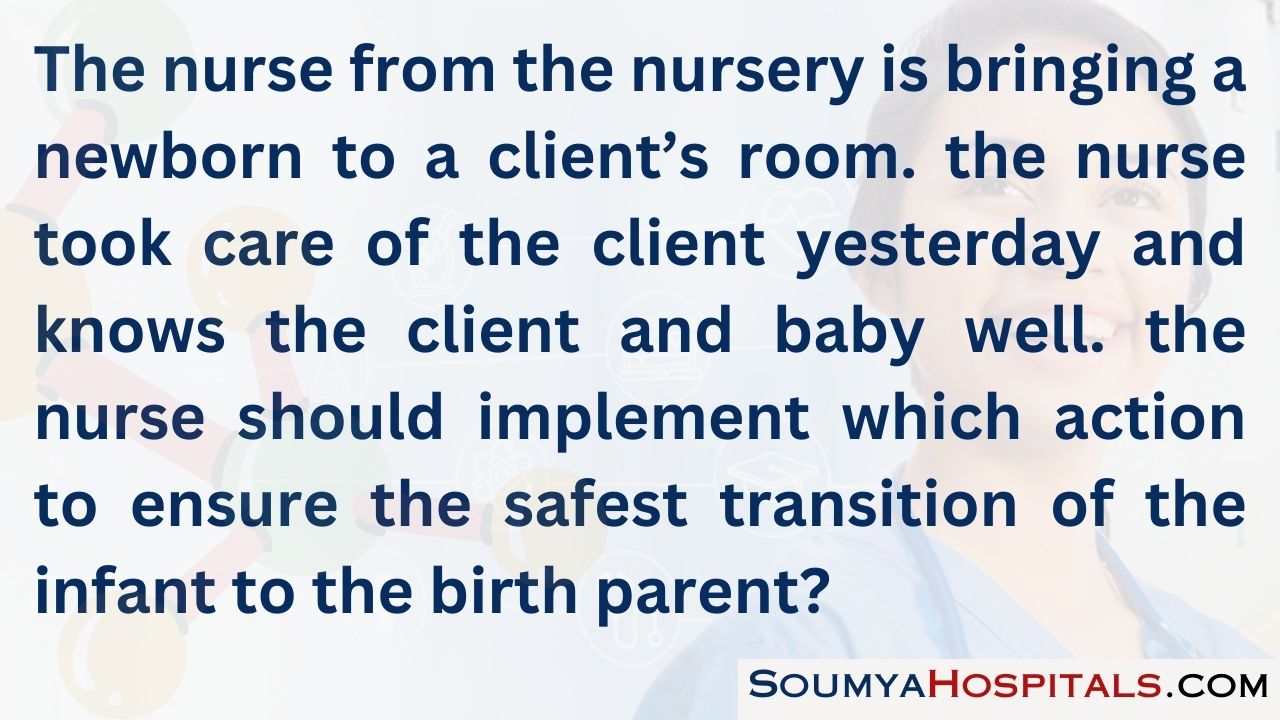
Explanation:
The hospital identification procedures for mothers and infants need to be completed each time a newborn is returned to a family’s room. It does not matter how well the nurse knows the mother and infant; this validation is a standard of care in an obstetrical setting.
Assessing the mother’s ability to ambulate, asking the mother if there is anything else she needs to care for the infant, and checking the crib to determine if there are enough supplies are important steps that are part of the process of transferring a baby to the mother, but identification verification is a safety measure that must occur first.
Question 2.
A client is in the first hour of her recovery after a vaginal birth. During an assessment, the lochia is moderate, is bright red, and is trickling from the vagina. The nurse locates the fundus at the umbilicus; it is firm and midline with no palpable bladder. The client’s vital signs remain at their baseline. Based on this information, the nurse would implement which action?
(a) Increase the IV rate.
(b) Recheck the admission hematocrit and hemoglobin levels.
(c) Report the findings to the health care provider (HCP).
(d) Document the findings as normal.
Answer:
(c) Report the findings to the health care provider (HCP).
Explanation:
At any point in the postpartum period, the lochia should be dark in color, rather than bright red. The volume should not be great enough to trickle or run from the vagina. The information provided states the fundus is firm, midline, and at the umbilicus, which are the expected outcomes at this point postpartum. These findings would indicate to the nurse that the bleeding is not coming from the uterus or from uterine atony. The bladder is not palpable, which indicates that the bleeding is not related to a full bladder, which is further validated by the fundus being at the umbilicus.
The most likely etiology is cervical or vaginal lacerations or tears. The nurse is unable to do anything to stop this type of bleeding and must notify the HCP. Increasing the IV rate will not decrease the amount or type of vaginal bleed-ing. Rechecking the hematocrit and hemoglobin will only provide background information for the nurse and identify the beginning levels for this mother, rather than where she is now. It will do nothing to stop the bleeding. The bleeding level and color is not normal, and documenting such findings as normal is incorrect.
Question 3.
The nurse is caring for a multigravida woman who is 1 day postpartum following a vaginal birth. Which finding indicates a need for further assessment?
(a) hemoglobin 12.1 g/dL (121 g/L)
(b) WBC count of 15,000 mcL (15 x 109/L)
(c) pulse of 60 beats/min
(d) temperature of 100.8°F (38.2°C)
Answer:
(d) temperature of 100.8°F (38.2°C)
Explanation:
Within the first 24 hours postpartum, maternal temperature may increase to 100.4°F (38°C), a normal postpartum finding attributed to dehydration. A temperature above 100.4°F (38°C) after the first 24 hours indicates a potential for infection. The hemoglobin is in the normal range. WBC count is normally elevated as a response to the inflammation, pain, and stress of the birthing process.
A pulse rate of 60 beats/min is normal at this period and results from an increased cardiac output (mobilization of excess extracellular fluid into the vascular bed, decreased pressure from the uterus on vessels, blood flow back to the heart from the uterus returning to the central circulation) and alteration in stroke volume.
Question 4.
The nurse is providing follow-up care to a client 10 days after the birth. The nurse would anticipate what outcomes from the new mother? Select all that apply.
(a) The client feels tired but is able to care for herself and her new infant.
(b) The family has adequate support from one another and others.
(c) Lochia is changing from red to pink and is smaller in amount.
(d) The client feeds the baby every 6 to 8 hours without difficulty.
(e) The client has positive comments about her new infant.
Answer:
(a) The client feels tired but is able to care for herself and her new infant.
(b) The family has adequate support from one another and others.
(c) Lochia is changing from red to pink and is smaller in amount.
(e) The client has positive comments about her new infant.
Explanation:
(a), (b), (c), (e) Outcome evaluation for a family about 7 days after birth would include a mother who is tired but is able to care for herself and her baby. Having adequate support systems enables the mother to care better for herself and family members, as they can provide the backup for situations that may arise and a resource for new families. The normal progression for lochia is to change from red to pink to off-white while decreasing in amount. This is within the usual time periods for a postpartum mother. The baby should be feeding more frequently than every 6 to 8 hours.
It is expected that a 7-day-old infant feeds every 3 to 4 hours if bottle-feeding and every lVz to 3 hours if breastfeeding. Follow-up questions the nurse would ask to further evaluate this situa¬tion include “How many wet diapers does the infant have daily? How alert is the infant? Did the infant gain any weight at the first checkup?” It is expected that the mother has positive comments about the infant, but the nurse will evaluate to determine if there is at least one positive comment.
Question 5.
A client gave birth vaginally 2 hours ago and has a third-degree laceration. There is ice in place on her perineum. However, her perineum is slightly edematous, and the client is having pain rated 6 on a scale of 1 to 10. Which nursing intervention would be the most appropriate at this time?
(a) Begin sitz baths.
(b) Administer pain medication per prescription.
(c) Replace ice packs to the perineum.
(d) Initiate prescription anesthetic sprays to the perineum.
Answer:
(b) Administer pain medication per prescription.
Explanation:
Pain medication is the first strategy to initiate at this pain level. When trauma has occurred to any area, the usual intervention is ice for the first 24 hours and heat after the first 24 hours. Sitz baths are initiated at the conclusion of ice therapy. Ice has already been initiated and will prevent further edema to the rectal sphincter and perineum and continue to reduce some of the pain. Anesthetic sprays can also be utilized for the perineal area when pain is involved but would not lower the pain to a level that the client considers tolerable.
Question 6.
A primigravid client gave birth vaginally 2 hours ago with no complications. As the nurse plans care for this postpartum client, which postpartum goal would have the highest priority?
(a) By discharge, the family will bond with the neonate.
(b) The nurse will demonstrate self-care and infant care by the end of the shift.
(c) The nurse will state instructions for discharge during the first postpartum day.
(e) By the end of the shift, the nurse will describe a safe home environment.
Answer:
(b) The nurse will demonstrate self-care and infant care by the end of the shift.
Explanation:
Educating the client about caring for herself and her infant are the two highest priority goals. Following birth, all mothers, especially the primi- gravida, require instructions regarding self-care and infant care. Learning needs should be assessed in order to meet the specific needs of each client.
Bonding is significant, but it is only one aspect of the needs of this client, and the bonding process would have been implemented immediately postpartum, rather than waiting 2 hours. Planning the discharge occurs after the initial education has taken place for mother and infant and the nurse is aware of any need for referrals. Safety is an aspect of education taught continuously by the nurse and should include maternal as well as newborn safety.
Question 7.
In response to the nurse’s question about how she is feeling, a postpartum client states that she is fine. She then begins talking to the baby, checking the diaper, and asking infant care questions. The nurse determines the client is in which postpartal phase of psychological adaptation?
(a) taking in
(b) taking on
(c) taking hold
(d) letting go
Answer:
(c) taking hold
Explanation:
The client is in the taking hold phase with a demonstrated focus on the neonate and learning about and fulfilling infant care and needs. The taking in phase is the first period after birth where there is emphasis on reviewing and reliving the labor and birth process, concern with self, and needing to be mothered. Eating and sleep are high priorities during this phase.
Taking on is not a phase of postpartum psychological adaptation. Letting go is the process beginning about 6 weeks postpartum when the mother may be preparing to go back to work. During this time, she can have other individuals assume care of the infant and begin the separation process.
Question 8.
At which location would the nurse expect to palpate the fundus of a primiparous client immediately after birth of a neonate?
(a) halfway between the umbilicus and the sym physis pubis
(b) at the level of the umbilicus
(c) just below the level of the umbilicus
(d) above the level of the umbilicus
Answer:
(a) halfway between the umbilicus and the symphysis pubis
Explanation:
Immediately after delivery of the placenta, the nurse would expect to palpate the fundus halfway between the umbilicus and the symphysis pubis. Within 2 hours postpartum, the fundus should be palpated at the level of the umbilicus. The fundus remains at this level or may rise slightly above the umbilicus for approximately 12 hours. After the first 12 hours, the fundus should decrease 1 fingerbreadth (1 cm) per day in size. By the 9th or 10th day, the fundus usually is no longer palpable.
Question 9.
The nurse assesses a swollen ecchymosed area to the right of an episiotomy on a primiparous client 6 hours after a vaginal birth. What should the nurse do next?
(a) Apply an ice pack to the perineal area.
(b) Assess the client’s temperature.
(c) Have the client take a warm sitz bath.
(d) Contact the health care provider (HCP) for prescriptions for an antibiotic.
Answer:
(a) Apply an ice pack to the perineal area.
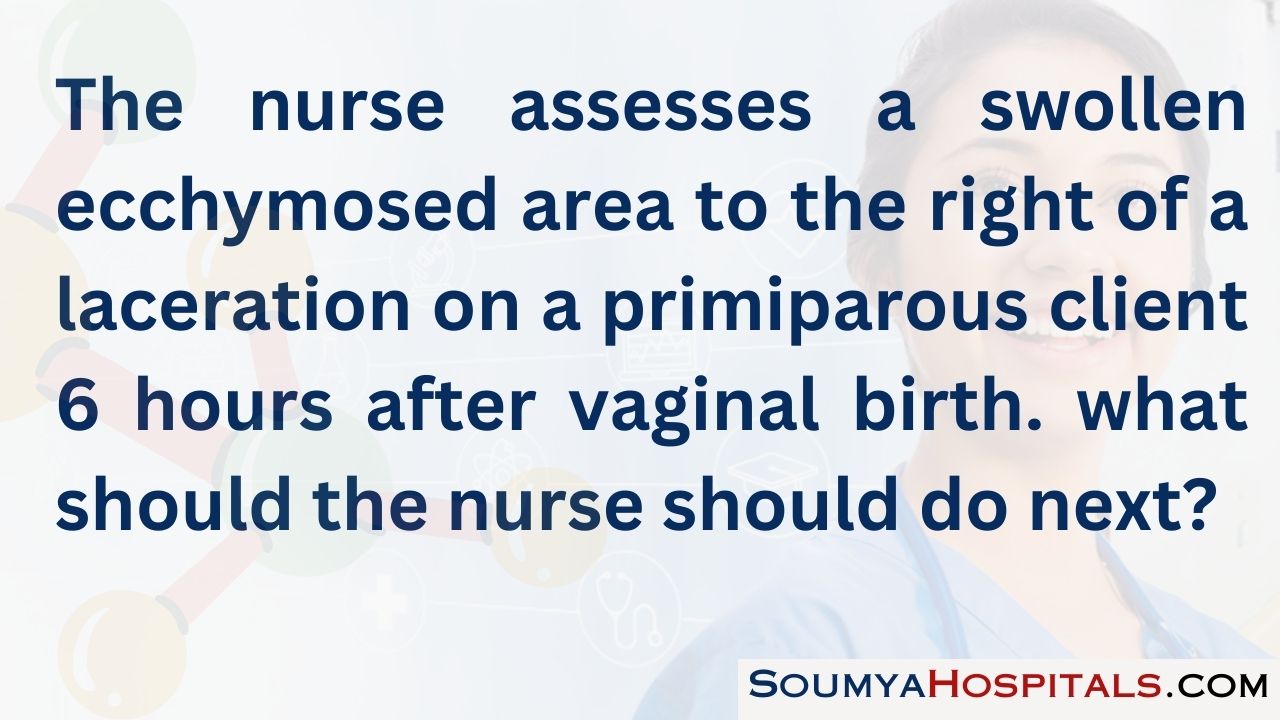
Explanation:
The client has a hematoma. During the first 24 hours postpartum, ice packs can be applied to the perineal area to reduce swelling and discomfort. Ice packs usually are not effective after the first 24 hours. Although vital signs, including temperature, are important assessments, taking the client’s temperature is unrelated to the hematoma and would provide no additional information about swelling. After 24 hours, the client may obtain more relief by taking a warm sitz bath.
This moist heat is an effective way to increase circulation to the perineum and provide comfort. Usually, hematomas resolve without further treatment within 6 weeks. Additionally, the nurse should measure the hematoma to provide a baseline for subsequent measurements and should notify the HCP |Q3 of its presence. An antibiotic is not warranted at this point because the client is not exhibiting any signs or symptoms of infection.
Question 10.
Two hours after a vaginal birth under epidural anesthesia, a client with a midline episiotomy ambulates to the bathroom to void. After voiding, the nurse assesses the client’s bladder, finding it distended. The nurse interprets this finding based on the understanding that the client’s bladder distention is most likely caused by which factor?
(a) prolonged first stage of labor
(b) urinary tract infection
(c) pressure of the uterus on the bladder
(d) edema in the lower urinary tract area
Answer:
(d) edema in the lower urinary tract area
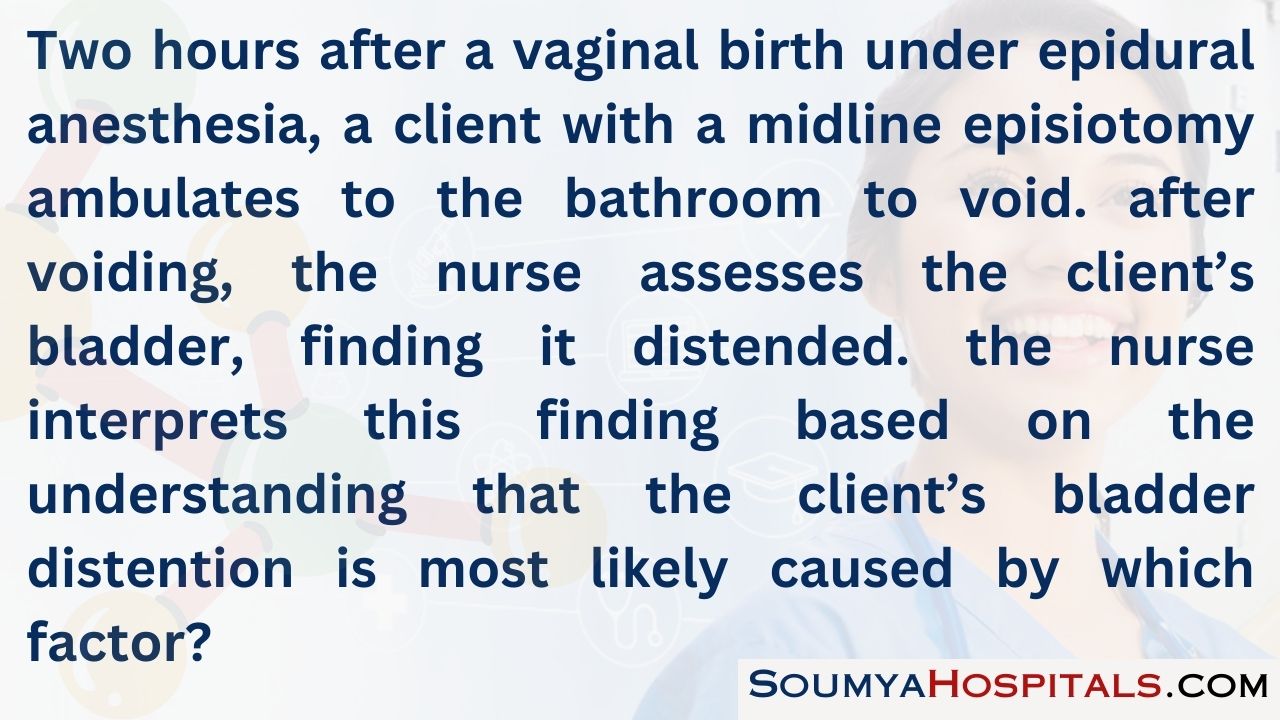
Explanation:
Urinary retention soon after birth is usually caused by edema and trauma of the lower urinary tract; this commonly results in difficulty with initiating voiding. Hyperemia of the bladder mucosa also commonly occurs. The combination of hyperemia and edema predisposes to decreased sensation to void, overdistention of the bladder, and incomplete bladder emptying.
A prolonged first stage of labor can contribute to exhaustion and uterine atony, not urinary retention. If the client had a urinary tract infection, she would exhibit symptoms such as dysuria and a burning sensation. After birth, the uterus is contracting, which leads to less pressure on the bladder. The pressure of the uterus on the bladder occurs during labor.
Question 11.
A primiparous client who is bottle-feeding her neonate at 12 hours after birth asks the nurse, “When will my menstrual cycle return?” Which response by the nurse would be most appropriate?
(a) “Your menstrual cycle will return in 3 to 4 weeks.”
(b) “It will probably be 6 to 10 weeks before it starts again.”
(c) “You can expect your menses to start in 12 to 14 weeks.”
(d) “Your menses will return in 16 to 18 weeks.”
Answer:
(b) “It will probably be 6 to 10 weeks before it starts again.”
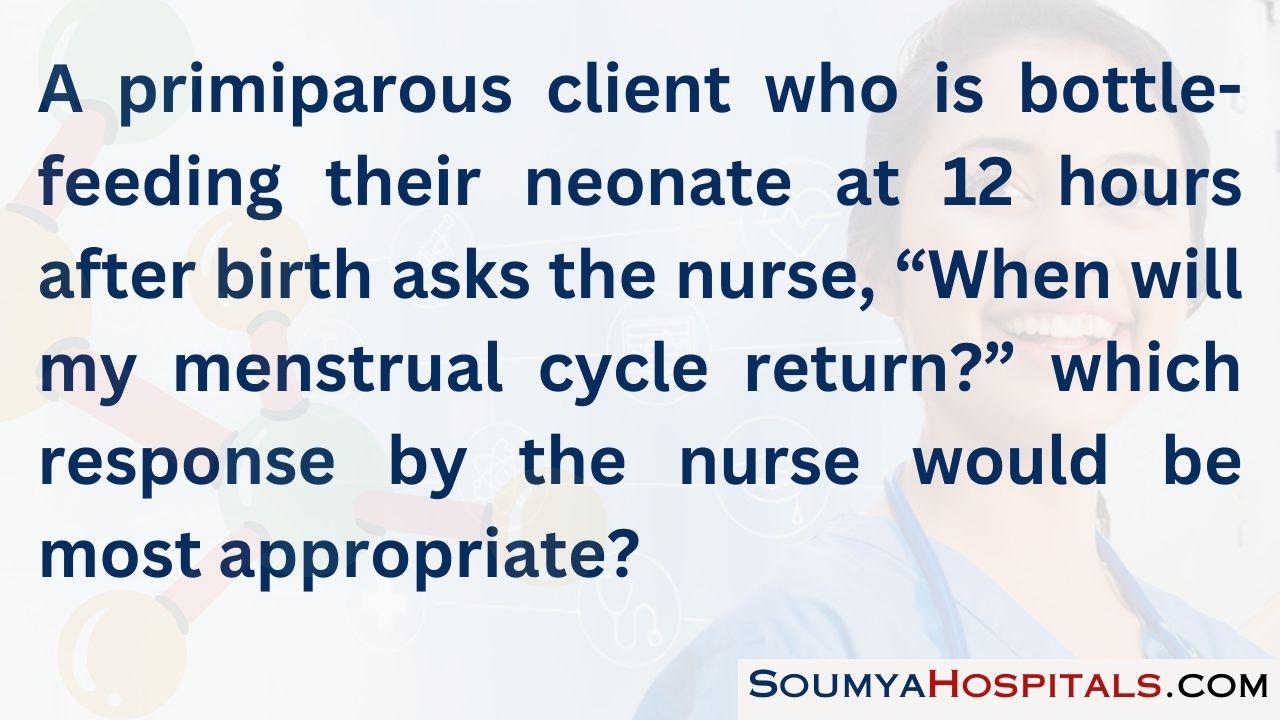
Explanation:
For clients who are bottle-feeding, the menstrual flow should return in 6 to 10 weeks, after a rise in the production of follicle-stimulating hormone by the pituitary gland. Nonlactating mothers rarely ovulate before 4 to 6 weeks postpartum. Therefore, 3 to 4 weeks is too early for the menstrual cycle to resume. For women who are breast-feeding, the menstrual flow may not return for 3 to 4 months (12 to 16 weeks) or, in some women, for the entire period of lactation, because ovulation is suppressed.
Question 12.
While the nurse is preparing to assist the primiparous client to the bathroom to void 6 hours after a vaginal birth under epidural anesthesia, the client says that she feels dizzy when sitting up on the side of the bed. The nurse explains that this is most likely caused by which factor?
(a) effects of the anesthetic during labor
(b) hemorrhage during the birth process
(c) effects of analgesics used during labor
(d) decreased blood volume in the vascular system
Answer:
(d) decreased blood volume in the vascular system
Explanation:
The client’s dizziness is most likely caused by orthostatic hypotension secondary to the decreased volume of blood in the vascular system resulting from the physiologic changes occurring in the mother after birth. The client is experiencing dizziness because not enough blood volume is available to perfuse the brain. The nurse should first allow the client to “dangle” on the side of the bed for a few minutes before attempting to ambulate.
By 6 hours postpartum, the effects of the anesthesia should be worn off completely. Typically, the effects of epidural anesthesia wear off by 1 to 2 hours post¬partum, and the effects of local anesthesia usually disappear by 1 hour. The client scenario provides no information to indicate that the client experienced any postpartum hemorrhage. Normal blood loss during birth should not exceed 500 mL.
Question 13.
Three hours postpartum, a primiparous client’s fundus is firm and midline. On perineal inspection, the nurse observes a small, constant trickle of blood. Which condition should the nurse assess further?
(a) retained placental tissue
(b) uterine inversion
(c) bladder distention
(d) perineal lacerations
Answer:
(d) perineal lacerations
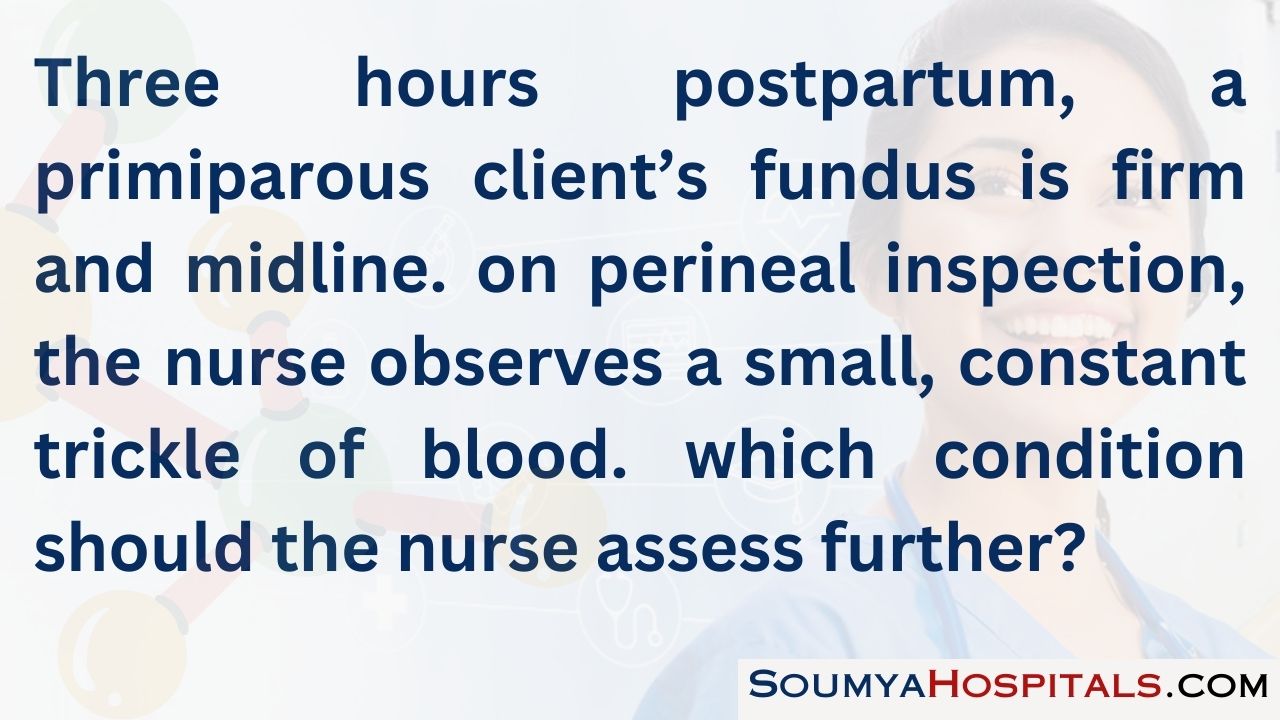
Explanation:
A small, constant trickle of blood and a firm fundus are usually indicative of a vaginal tear or cervical laceration. If the client had retained placental tissue, the fundus would fail to contract fully (uterine atony), exhibiting a soft or boggy fundus. Also, vaginal bleeding would be evident.
Uterine inversion occurs when the uterus is displaced outside of the vagina and is obvious on inspection. Bladder distention may result in uterine atony because the pressure of the bladder displaces the fundus, preventing it from fully contracting. In this case, the fundus would be soft, possibly boggy, and displaced from the midline.
Question 14.
At a postpartum checkup 11 days after birth, the nurse asks the client about the color of her lochia. Which color is expected?
(a) dark red
(b) pink
(c) brown
(d) white
Answer:
(d) white
Explanation:
On about the 11th postpartum day, the lochia should be lochia alba, clear or white in color. Lochia rubra, which is dark red to red, may persist for the first 2 to 3 days postpartum. From day 3 to about day 10, lochia serosa, which is pink or brown, is normal.
Question 15.
After instructing a primiparous client about episiotomy care, which client statement indicates successful teaching?
(a) “I will use hot, sudsy water to clean the episiotomy area.”
(b) “I wipe the area from front to back using a blotting motion.”
(c) “Before bedtime, I will use a cold water sitz bath.”
(d) “I can use ice packs for 3 to 4 days after birth. ”
Answer:
(b) “I wipe the area from front to back using a blotting motion.”
Explanation:
The nurse should instruct the client to cleanse the perineal area with warm water and to wipe from front to back with a blotting motion. Warm water is soothing to the tender tissue, and wiping from front to back reduces the risk of con-tamination. Hot, sudsy water may increase the client’s discomfort and may even burn the client in a very tender area. After the first 24 hours, warm water sitz baths taken three or four times a day for 20 minutes can help increase circulation to the area. Ice packs are helpful for the first 24 hours.
Question 16.
A primiparous client, 20 hours after birth, asks the nurse about starting postpartum exercises. Which instruction would be most appropriate to include in the plan of care?
(a) Start in a sitting position, then lie back, and return to a sitting position, repeating this five times.
(b) Assume a prone position, and then do pushups by using the arms to lift the upper body.
(c) Flex the knees while supine, and then inhale deeply and exhale while contracting the abdominal muscles.
(d) Flex the knees while supine, and then bring chin to chest while exhaling and reach for the knees by lifting the head and shoulders while inhaling.
Answer:
(c) Flex the knees while supine, and then inhale deeply and exhale while contracting the abdominal muscles.
Explanation:
After an uncomplicated birth, postpartum exercises may begin on the first postpartum day with exercises to strengthen the abdominal muscles. These are done in the supine position with the knees flexed, inhaling deeply while allowing the abdomen to expand and then exhaling while contracting the abdominal muscles.
Exercises such as sit-ups (sitting, then lying back, and returning to a sitting position) and push-ups or exercises involving reaching for the knees are ordinarily too strenuous for the first postpartum day. Sit-ups may be done later in the postpartum period, after approximately 3 to 6 weeks.
Question 17.
A multiparous client whose fundus is firm and midline at the umbilicus 8 hours after a vaginal birth tells the nurse that when she ambulated to the bathroom after sleeping for 4 hours, her dark red lochia seemed heavier. Which information would the nurse include when explaining to the client about the increased lochia on ambulation?
(a) The increased lochia needs to be reported to the health care provider (HCP) immediately.
(b) The increased lochia occurs from lochia pooling in the vaginal vault.
(c) The increase in lochia may be an early sign of postpartum hemorrhage.
(d) This increase in lochia usually indicates retained placental fragments.
Answer:
(b) The increased lochia occurs from lochia pooling in the vaginal vault.

Explanation:
Lochia can be expected to increase when the client first ambulates. Lochia tends to pool in the uterus and vagina when the client is recumbent and flows out when the client arises. If the client had reported that her lochia was bright red, the nurse would have suspected bleeding. In this situation, the client would be put back in bed and would be notified.
Early postpartum hemorrhage occurs during the first 24 hours, but typically the fundus is soft or “boggy.” The client’s fundus here is firm and midline. Late postpartum hemorrhage, occurring after the first 24 hours, is usually caused by retained placental fragments or abnormal involution of the placental site.
Question 18.
A primiparous client who gave birth vaginally 8 hours ago desires to take a shower. The nurse anticipates remaining near the client to assess for which problem?
(a) fatigue
(b) fainting
(c) diuresis
(d) hygiene needs
Answer:
(b) fainting
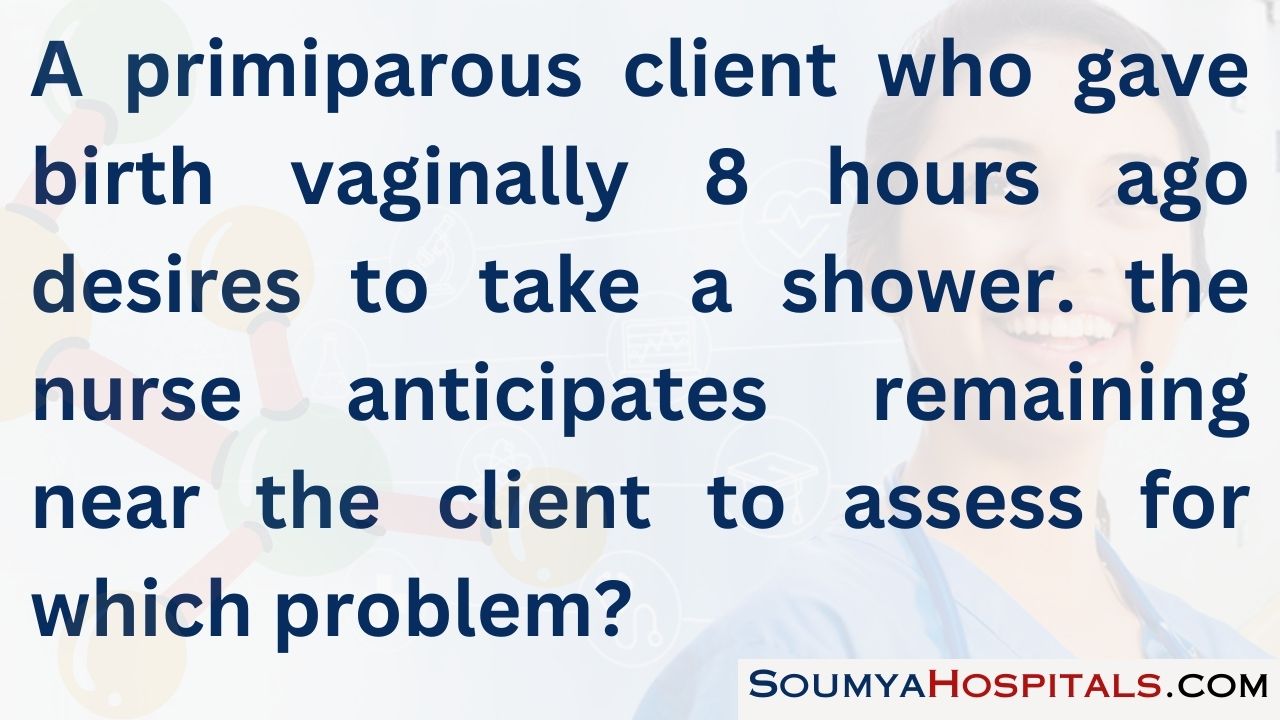
Explanation:
Clients sometimes feel faint or dizzy when taking a shower for the first time after birth because of the sudden change in blood volume in the body. Primarily for this reason, the nurse remains nearby while the client takes her first shower after birth. If the client becomes dizzy or expresses symptoms of feeling faint, the nurse should get the client back to bed as soon as possible.
If the client faints while in the shower, the nurse should cover the client to protect her privacy, stay with the client, and call for assistance. Fatigue postpartum is common and will precede taking a shower. Diuresis is a normal physiologic response during the postpartum period and not associated with showering. Hygiene needs also precede the shower.
Question 19.
A primiparous client who gave birth 12 hours ago under epidural anesthesia with a midline episiotomy tells the nurse that she is experiencing a great deal of discomfort when she sits in a chair with the baby. Which instructions would be most appropriate?
(a) “Ask for some pain medication before you sit down.”
(b) “Squeeze your buttock muscles together before sitting down.”
(c) “Keep a relaxed posture before sitting down with your full weight.”
(d) “Ask the health care provider for some analgesic cream or spray.”
Answer:
(b) “Squeeze your buttock muscles together before sitting down.”
Explanation:
The nurse should instruct the client to squeeze or contract the muscles of the buttocks together before sitting down in the chair; this contracts the pelvic floor muscles, which reduces the tension in the tender perineal area. Then the client should put her full weight slowly down on the chair. Pain medication may only be prescribed every 3 to 4 hours, so the client may not be able to receive pain medication every time she desires to sit in the chair.
The episiotomy pain usually fades by the 5th or 6th postpartum day. Maintaining a relaxed posture before sitting does not contract the pelvic floor muscles. Most healthcare providers (HCPs) prescribe an analgesic cream or spray when a client has an episiotomy, but they provide only temporary relief.
Question 20.
Which information would the nurse include in the primiparous client’s discharge teaching plan about measures to provide visual stimulation for the neonate?
(a) Maintain eye contact while talking to the baby.
(b) Paint the baby’s room in bright colors accented with teddy bears.
(c) Use brightly colored animals and cartoon figures on the wall.
(d) Move a brightly colored rattle in front of the baby’s eyes.
Answer:
(a) Maintain eye contact while talking to the baby.

Explanation:
Neonates like to look at eyes, and eye-to-eye contact is a highly effective way to provide visual stimulation. The parent’s eyes are circular, move from side to side, and become larger and smaller. Neonates have been observed to fix them. In general, neonates prefer circular objects of darkness against a white background. Sharp black-and-white images of geometric figures are appropriate.
The use of bright colors on the walls and moving a colorful rattle do not provide as much visual stimulation as eye-to-eye contact with talking. Brightly colored animals and cartoon figures are more appropriate at approximately 1 year of age.
Question 21.
An adolescent primiparous client 24 hours postpartum asks the nurse how often she can hold her baby without “spoiling” him. Which response would be most appropriate?
(a) “Hold him when he is fussy or crying.”
(b) “Hold him as much as you want to hold him.”
(c) “Try to hold him infrequently to avoid overstimulation. ”
(d) “You can hold him periodically throughout the day.”
Answer:
(b) “Hold him as much as you want to hold him.”
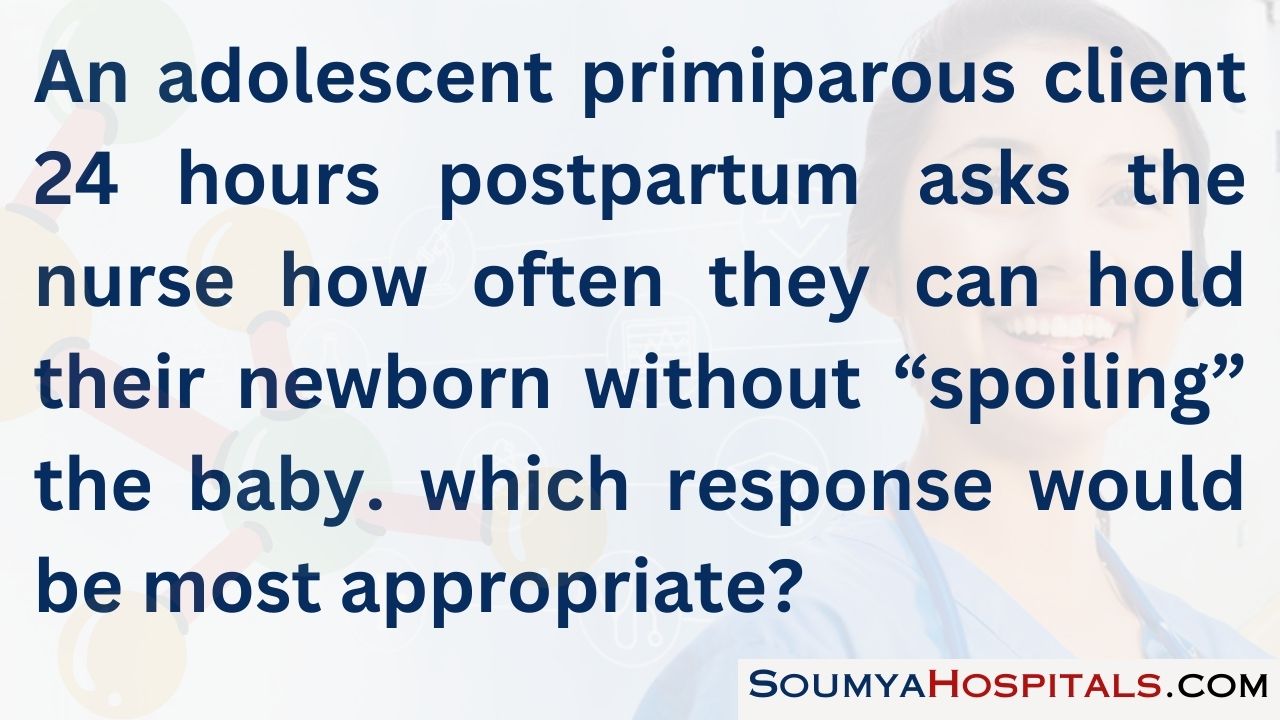
Explanation:
According to Erikson, infants are in the trust versus mistrust stage. Holding, talking to, singing to, and patting neonates helps them develop trust in caregivers. Tactile stimulation is important and should be encouraged. Holding neonates often is unlikely to spoil them because they are totally dependent on other human beings to meet their needs.
Being held makes infants feel loved and cared for and should be encouraged. The mother can hold the neonate as often as she wants, not just when the baby is crying or fussy. Overstimulation typically does not result from holding an infant.
Question 22.
On the first postpartum day, the primiparous client reports perineal pain of 5 on a scale of 1 to 10 that was unrelieved by ibuprofen 800 mg given 2 hours ago. The nurse should further assess the client for which complication?
(a) puerperal infection
(b) vaginal lacerations
(c) history of drug abuse
(d) perineal hematoma
Answer:
(d) perineal hematoma
Explanation:
If the client continues to have perineal pain after an analgesic medication has been given, the nurse should inspect the client’s perineum for a hematoma because this is the usual cause of such discomfort. Ibuprofen is a nonsteroidal antiinflammatory medication used to relieve mild pain. Pain from a perineal hematoma can be moderate to severe, possibly requiring a stronger analgesic, such as acetaminophen with codeine).
Ice applied to the perineum during the first 24 hours postpartum may decrease the severity of hematoma formation. Application of warm heat, such as a sitz bath three times daily for 20 minutes, also can help to relieve the discomfort when implemented after the first 24 hours. Typically, hematomas resolve themselves within 6 weeks. A puerperal infection would be indicated if the client’s temperature were 100.4°F (41°C) or higher. Also, lochia most likely would be foul smelling. A continuous trickle of lochia rubra would suggest a possible vaginal laceration. No evidence is presented to suggest a history of drug abuse.
Question 23.
The nurse working on the postpartum unit is in charge of a team that includes an unlicensed assistive personnel (UAP). Which task would the nurse question if completed by the UAP caring for a 1 day postpartum client?
(a) changing the perineal pad and reporting the drainage
(b) teaching the mother to latch the infant onto the breast
(c) reinforcing good hygiene while assisting the client with washing the perineum
(d) assisting the client with ambulation shortly after birth
Answer:
(b) teaching the mother to latch the infant onto the breast
Explanation:
Delegating care to UAP QJ requires that the nurse knows which tasks are within that individual’s capability. Changing the perineal pad and reporting drainage, reinforcing hygiene with perineal care, and assisting with ambulation are within the individual’s capacity. It would be beyond the scope of the job of UAP to conduct client teaching.
Question 24.
While the nurse is caring for a primiparous client on the first postpartum day, the client asks, “How is that woman doing who lost her baby from prematurity? We were in labor together.” Which response by the nurse would be most appropriate?
(a) Ignore the client’s question and continue with morning care.
(b) Tell the client, “I’m not sure how the other woman is doing today.”
(c) Tell the client, “I need to ask the woman’s permission before discussing her well-being.”
(d) Explain to the client that “nurses are not allowed to discuss other clients on the unit.”
Answer:
(d) Explain to the client that “nurses are not allowed to discuss other clients on the unit.”
Explanation:
Legal regulations and ethical decision-making require that the nurse maintain confidentiality at all times. The nurse’s best response is to explain to the client that nurses are not allowed to discuss other clients on the unit. Ignoring the client’s question is inappropriate because doing so would interfere with the development of a trusting nurse-client relationship. Confidentiality must be maintained at all times.
Telling the client that the nurse is not sure may imply that the nurse will find out and then tell the client about the other woman. Asking the other woman’s permission to discuss her with another client is inappropriate because confidentiality must be maintained at all times.
Question 25.
A newly postpartum primiparous client asks the nurse, “Can my baby see?” Which statement about neonatal vision should the nurse include in the explanation?
(a) Neonates primarily focus on moving objects.
(b) They can see objects up to 12 inches (30.5 cm) away.
(c) Usually they see clearly by about 2 days after birth.
(d) Neonates primarily distinguish light from dark.
Answer:
(b) They can see objects up to 12 inches (30.5 cm) away.

Explanation:
The neonate has immature oculomotor coordination, an inability to accommodate for distance, and poorly developed eyes, visual nerves, and brain. However, the normal neonate can see objects clearly within a range of 9 to 12 inches (22.9 to 30.5 cm), whether or not the neonate is moving. Visual acuity at birth is 20/100 to 20/150, but it improves rapidly during infancy and toddlerhood. Newborns can distinguish colors as well as light from dark.
Question 26.
While assessing the fundus of a multiparous client 36 hours after the birth of a term neonate, the nurse notes a separation of the abdominal muscles. What should the nurse tell the client?
(a) that she will have a surgical repair at 6 weeks postpartum
(b) to remain on bed rest until resolution occurs
(c) that the separation will resolve on its own with the right posture and diet
(d) to perform exercises involving head and shoulder raising in a lying position
Answer:
(d) to perform exercises involving head and shoulder raising in a lying position
Explanation:
The client is experiencing diastasis recti, a separation of the longitudinal muscles (recti) of the abdomen that is usually palpable on the 3rd postpartum day. An exercise involving raising the head and shoulders about 8 inches (20.3 cm) with the client lying on her back with knees bent and hands crossed over the abdomen is preferred. This exercise helps to pull the abdominal muscles together, and the client gradually works up to performing this exercise 50 times per day.
However, until the diastasis has closed, the client should avoid exercises that rotate the trunk, twist the hips, or bend the trunk to one side because further separation may occur. The condition does not need a surgical repair, and limited activity and bed rest are not necessary. Correct posture and adequate diet assist the body to return to its prepregnancy state more quickly but do not resolve the separation of abdominal muscles.
Question 27.
A postpartum client gave birth 6 hours ago without anesthesia and just voided 100 mL. The nurse palpates the fundus 2 fingerbreadths above the umbilicus and off to the right side. What should the nurse do first?
(a) Administer ibuprofen.
(b) Reassess in 1 hour.
(c) Catheterize the client.
(d) Obtain a prescription for a fluid bolus.
Answer:
(c) Catheterize the client.
Explanation:
A uterine fundus located off to one side and above the level of the umbilicus is commonly the result of a full bladder. Although the client had voided, the client may be experiencing urinary retention with overflow. If anesthesia has been used for birth, the inability to void may be related to the lingering effects of anesthesia; however, that is not the case here.
Health care providers (HCPs) commonly write a one-time prescription for catheterization, after which, typically, enough edema has subsided to make it easier and less painful for the client to void and completely empty her bladder. Administering ibuprofen would have no effect on the uterine fundus. Waiting to reassess in 1 hour could be detrimental since the client’s distended bladder is interfering with uterine involution, pre-disposing her to possible hemorrhage. Administering a bolus of fluid would be inappropriate because it would only add to the client’s full bladder.
Question 28.
While the nurse is assessing the fundus of a multiparous client who gave birth 24 hours ago, the client asks, “What can I do to get rid of these stretch marks?” Which response would be most appropriate?
(a) “As long as you do not get pregnant again, the marks will disappear completely.”
(b) “They usually fade to a silvery-white color over a period of time.”
(c) “You will need to use a specially prescribed cream to help them disappear.”
(d) "If you lose the weight you gained during pregnancy, the marks will fade to a pale pink.”
Answer:
(b) “They usually fade to a silvery-white color over a period of time.”

Explanation:
Stretch marks, or striae gravidarum, are caused by stretching of the tissues, particularly over the abdomen. After birth, the tissues atrophy, leaving silver scars. These skin pigmentations will not disappear completely. The striae gravidarum may reappear as pink streaks if the client becomes pregnant again. Special creams are not warranted because they are not helpful and may be expensive. Weight loss does not make the marks disappear. Striae gravidarum tends to run in families.
Question 29.
A primiparous client who gave vaginal birth to a viable term neonate 48 hours ago has a nridline episiotomy and repair of a third-degree laceration. When preparing the client for discharge, which assessment would be most important?
(a) constipation
(b) diarrhea
(c) excessive bleeding
(d) rectal fistulas
Answer:
(a) constipation
Explanation:
The client with a third-degree laceration should be assessed for constipation because a third-degree laceration extends into a portion of the anal sphincter. Constipation, not diarrhea, is more likely because this condition is extremely painful, possibly causing the client to be reluctant to have a bowel movement. The laceration has been sutured and should not be bleeding at 48 hours postpartum. Rectal fistulas may develop at a later time, but not at 48 hours postpartum.
Question 30.
In preparation for discharge, the nurse discusses sexual issues with a multiparous client who had a routine vaginal birth with a nridline episiotomy. The client asks, “I’ve heard recommendations about when to resume intercourse have changed since my last baby. What are they saying now?” When should the nurse instruct the client that she can resume sexual intercourse?
(a) in 6 weeks when the episiotomy is completely healed
(b) after a postpartum check by the health care provider (HCP)
(c) whenever the client is feeling amorous and desirable
(d) when lochia flow and episiotomy pain have stopped
Answer:
(d) when lochia flow and episiotomy pain have stopped
Explanation:
For most clients, sexual intercourse can be resumed when the lochia has stopped flowing and episiotomy pain has ceased, usually about 3 weeks postpartum. Sexual intercourse may be painful until the episiotomy has healed. The client also needs instructions about the possibility that pregnancy may occur before the return of the client’s menstrual flow.
The postpartum check by the HCP typically occurs 4 to 6 weeks after birth, and most women have already had intercourse by this time. Typically, new mothers are exhausted and may not feel amorous or desirable for quite a while. In addition, the mother’s physiologic responses may be diminished because of low hormonal levels, adjustments to the maternal role, and fatigue due to lack of rest and sleep.
Question 31.
While caring for a multiparous client 4 hours after vaginal birth of a term neonate, the nurse notes that the mother’s temperature is 99.8°F (37.2°C), the pulse is 66 beats/min, and the respirations are 18 breaths/min. Her fundus is firm, midline, and at the level of the umbilicus. What should the nurse do?
(a) Continue to monitor the client’s vital signs.
(b) Assess the client’s lochia for large clots.
(c) Notify the client’s health care provider (HCP) about the findings.
(d) Offer the mother an ice pack for her forehead.
Answer:
(a) Continue to monitor the client’s vital signs.
Explanation:
The nurse needs to continue to monitor the client’s vital signs. During the first 24 hours postpartum, it is normal for the mother to have a slight temperature elevation because of dehydration. A temperature of 100.4°F (38°C) that persists after the first 24 hours may indicate an infection. Bradycardia during the first week postpartum is normal because of decreased blood volume, diuresis, and diaphoresis. The client’s respiratory rate is within normal limits.
Large clots are indicative of hemorrhage. However, the client’s vital signs are within normal limits and her fundus is firm and midline. Therefore, large clots and possible hemorrhage can be ruled out. The HCP does not need to be notified at this time. An ice pack is not necessary because the client’s temperature is within normal limits.
Question 32.
While assessing the episiotomy site of a primiparous client on the first postpartum day, the nurse observes a fairly large hemorrhoid at the client’s rectum. After instructing the client about measures to relieve hemorrhoid discomfort, which client statement indicates the need for additional teaching?
(a) “I should ask my health care provider about using a stool softener.”
(b) “Analgesic sprays and witch hazel pads can relieve the pain.”
(c) “I should lie on my back as much as possible to relieve the pain.”
(d) “I should drink lots of water and eat foods that have a lot of roughage.”
Answer:
(b) “Analgesic sprays and witch hazel pads can relieve the pain.”
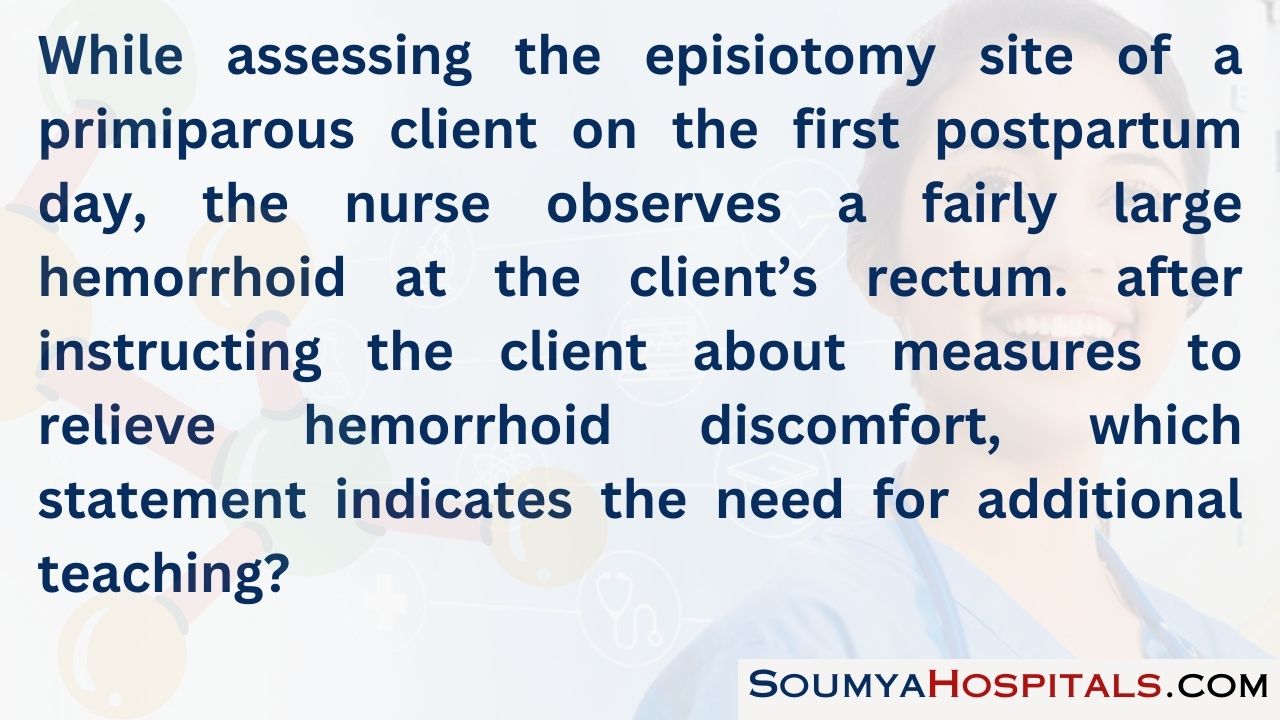
Explanation:
The client needs more teaching when she states, “I should lie on my back as much as possible to relieve the pain.” Instead, the client should lie in the Sims position as much as possible to aid venous return to the rectal area and to reduce discomfort. Stool softeners can decrease pain with defecation, but clients should discuss their use with their provider before taking them. Analgesic sprays and witch hazel pads are helpful in reducing the discomfort of hemorrhoids.
Drinking lots of water and eating roughage aid in bowel elimination, minimizing the risk of straining and subsequent hemorrhoidal development or enlargement.
Question 33.
A primiparous client is on a regular diet 24 hours postpartum. The client’s mother asks the nurse if she can bring her daughter some “special foods from home. ” The nurse responds based on the understanding about which principle?
(a) Foods horn home are generally discouraged on the postpartum unit.
(b) The mother can bring the daughter any foods that she desires.
(c) This is permissible as long as the foods are nutritious and high in iron.
(d) The client’s health care provider (HCP) needs to give permission for the foods.
Answer:
(b) The mother can bring the daughter any foods that she desires.

Explanation:
On most postpartum units, clients on regular diets are allowed to eat whatever kinds of food they desire. Generally, foods from home are not discouraged. The nurse does not need to obtain the HCP’s [y] permission. Although it is preferred, the foods do not necessarily have to be high in iron.
In some cultures, there is a belief in the “hot-cold” the-ory of disease; certain foods (hot) are preferred during the postpartum period, and other foods (cold) are avoided. Therefore, the nurse should allow the mother to bring her daughter “special foods from home.” Doing so demonstrates cultural sensitivity and aids in developing a trusting relationship.
Question 34.
A primiparous client, 48 hours after a vaginal birth, is to be discharged with a prescription for vitamins with iron because she is anemic. To maximize absorption of the iron, the nurse instructs the client to take the medication with which liquid?
(a) orange juice
(b) herbal tea
(c) milk
(d) grape juice
Answer:
(a) orange juice
Explanation:
Iron is best absorbed in an acid environ¬ment or with vitamin C. For maximum iron absorption, the client should take the medication with orange juice or a vitamin C supplement. Herbal tea has no effect on iron absorption. Milk decreases iron absorption. Grape juice is not acidic and therefore would have no effect on iron absorption.
Question 35.
The nurse is caring for a multiparous client after vaginal birth of a set of twins 2 hours ago. What should the nurse encourage the mother and partner to do?
(a) Bottle-feed the twins to prevent exhaustion and fatigue.
(b) Plan for each parent to spend equal amounts of time with each twin.
(c) Avoid assistance from other family members until attachment occurs.
(d) Relate to each twin individually to enhance the attachment process.
Answer:
(d) Relate to each twin individually to enhance the attachment process.
Explanation:
It is believed that the process of attachment is structured so that the parents become attached to only one infant at a time. Therefore, the nurse should encourage the parents to relate to each twin individually, rather than as a unit, to enhance the attachment process. Mothers of twins are usually able to breastfeed successfully because the milk supply increases on demand.
However, possible fatigue and exhaustion require that the mother rest whenever possible. It would be highly unlikely and unrealistic that each parent would be able to spend equal amounts of time with both twins. Other responsibilities, such as employment, may prevent this. The parents should try to engage assistance from family and friends because caring for twins or other multiple births (e.g., triplets) can be exhausting for the family.
Question 36.
Twelve hours after a vaginal birth with epidural anesthesia, the nurse palpates the fundus of a primiparous client and finds it to be firm, above the umbilicus, and deviated to the right. What should the nurse do next?
(a) Document this as a normal finding in the client’s record.
(b) Contact the health care provider (HCP) for a prescription for oxytocin.
(c) Encourage the client to ambulate to the bathroom and void.
(d) Gently massage the fundus to expel the clots.
Answer:
(c) Encourage the client to ambulate to the bathroom and void.
Explanation:
At 12 hours postpartum, the fundus normally should be in the midline and at the level of the umbilicus. When the fundus is firm yet above the umbilicus, and deviated to the right rather than in the midline, the client’s bladder is most likely distended. The client should be encouraged to ambulate to the bathroom and attempt to void because a full bladder can prevent normal involution.
A firm but deviated fundus above the level of the umbilicus is not a normal finding, and if voiding does not return it to midline, it should be reported to the HCP Oxytocin is used to treat uterine atony. This client’s fundus is firm, not boggy or soft, which would suggest atony. Gentle massage is not necessary because there is no evidence of atony or clots.
Question 37.
A nurse is discussing discharge instructions with a client. Which statement indicates that the client understands the resources and information available if needed after discharge? Select all that apply.
(a) “My fertility can return as early as 21 days after my baby’s birth.”
(b) “I have the hospital phone number if I have any questions.”
(c) “If I have any breathing problems, chest pain, or pounding fast heart rate, I will seek medical assistance.”
(d) “My mother is coming to help for a month, so I will be line.”
(e) “I know if I get fever or chills or change in lochia to call the health care provider.”
(f) “I will continue my prenatal vitamins until my postpartum checkup or longer. ”
Answer:
(a) “My fertility can return as early as 21 days after my baby’s birth.”
(b) “I have the hospital phone number if I have any questions.”
(c) “If I have any breathing problems, chest pain, or pounding fast heart rate, I will seek medical assistance.”
(e) “I know if I get fever or chills or change in lochia to call the health care provider.”
(f) “I will continue my prenatal vitamins until my postpartum checkup or longer. ”
Explanation:
(a), (b), (c), (e), (f) The nurse is responsible for providing discharge instructions that include signs and symptoms that need to be reported to the health care provider (HCP) as well as resources and follow-up for home care if needed. Phone numbers and health practices to promote healing, such as the use of prenatal vitamins, are also essential pieces of information.
Fertility can return in as little as 21 days, especially among women who are not breast¬feeding, so it is important to discuss the client’s contraception plan. Although the client’s mother may be helpful, the client’s statement that she will be fine because her mother is coming indicates that she is unaware or ignoring information about valuable information and resources.
Question 38.
The nurse is reviewing discharge instructions with a postpartum breastfeeding client who is going home. She has chosen depot medroxy progesterone acetate (DMPA) injections as birth control. Which statement by the client identifies that she needs further instruction concerning birth control?
(a) “I will wait for my 6-week checkup to get my first birth control injection.”
(b) “Depot injections last for 90 days.”
(c) “My milk supply should be well established before receiving a birth control injection.”
(d) “You will give me my first depot injection before I leave today.”
Answer:
(d) “You will give me my first depot injection before I leave today.”
Explanation:
Depot medroxyprogesterone acetate (DMPA) is an injectable progestin contraceptive that can reduce the initial production of breast milk. It is given to a breastfeeding woman when she returns for the 6-week postpartum checkup. By this time, the milk supply is well established and will remain at that level. DMPA is effective as a contraceptive for 90 days. DMPA can be given within 5 days of birth only if a mother is not breastfeeding
Question 39.
A postpartum primiparous client is having difficulty breastfeeding her infant. The infant latches on to the breast, but the mother’s nipples are extremely sore during and after each feeding. The client needs further instruction about breastfeeding when she makes which statement?
(a)“The baby needs to have as much of the nipple and areola in the mouth as possible to prevent sore and cracked nipples.”
(b) "I can put breast milk on my nipples to heal the sore areas.”
(c) “As long as some of my nipple is in the baby’s mouth, the baby will receive enough milk.”
(d) “Feeding the baby for a half-hour on each side will not make my breasts sore.”
Answer:
(c) “As long as some of my nipple is in the baby’s mouth, the baby will receive enough milk.”
Explanation:
As much of the mother’s nipple and areola as possible need to be in the infant’s mouth in order to establish a latch that does not cause nipple cracks or fissures. Having the nipple and the areola deep in the infant’s mouth decreases the stress on the end of the nipple, therefore decreasing pain, cracking, and fissures.
Breast milk has been found to heal nipples when placed on the nipple at the completion of a feeding. The length of time the baby feeds on each nipple is not a factor as long as the nipple is correctly placed in the infant’s mouth.
Question 40.
The nurse is caring for a primipara who gave birth yesterday and has chosen to breastfeed her neonate. Which assessment finding is considered unusual for the client at this point postpartum?
(a) milk production
(b) diaphoresis
(c) constipation
(d) diuresis
Answer:
(a) milk production
Explanation:
New mothers usually begin to produce milk at about the 3rd day postpartum and colostrum is produced until that time. For clients who have breastfed another infant during pregnancy, having milk shortly after birth is not unusual. Diaphoresis and diuresis are considered normal during this time as the body excretes the additional fluids that are no longer needed after the pregnancy. Constipation may continue for several days as a result of progesterone remaining in the system, the consummation of iron, and trauma to the perineum.
Question 41.
The nurse is caring for several mother-baby couplets. In planning the care for each of the couplets, which mother would the nurse expect to have the most severe afterbirth pains?
(a) G4, Pi client who is breastfeeding her infant
(b) G3, P3 client who is breastfeeding her infant
(c) G2, P2 cesarean client who is bottle-feeding her infant
(d) G3, P3 client who is bottle-feeding her infant
Answer:
(b) G3, P3 client who is breastfeeding her infant
Explanation:
The major reasons for afterbirth pains are breastfeeding, high parity, overdistended uterus during pregnancy, and a uterus filled with blood clots. Physiologically, afterbirth pains are caused by intermittent contraction and relaxation of the uterus. These contractions are stronger in multigravidas in order to maintain a contracted uterus. The release of oxytocin when breastfeeding also stimulates uter-ine contractions. There are no data to suggest any of these clients has had an overdistended uterus or currently has clots within the uterus.
The G3, P3 client who is breastfeeding has the highest parity of the clients listed, which in addition to breastfeeding places her most at risk for afterbirth pains. The G2, P2 postcesarean client may have cramping, but it should be less than the G3, P3 client. The G3, P3 client who is bottle-feeding would be at risk for afterbirth pains because she has given birth to several children, but her choice to bottle-feed reduces her risk of pain.
Question 42.
A breastfeeding client is seen at home by the visiting nurse 10 days after a vaginal birth. The client has a warm, red, painful breast, a temperature of 100°F (37.7°C), and flu-like symptoms. What should the nurse do?
(a) Encourage the client to breastfeed her infant using the unaffected breast.
(b) Refer the woman to her health care provider (HCP).
(c) Inform the client that she needs to discontinue breastfeeding.
(d) Instruct the woman to apply warm compresses to the affected breast.
Answer:
(b) Refer the woman to her health care provider (HCP).
Explanation:
The client is exhibiting signs and symptoms of a breast infection (mastitis). The nurse should instruct her to contact her HCP, who will likely prescribe a prescription for antibiotics. She should continue to breastfeed the infant from both breasts. Frequent breastfeeding is encouraged rather than discontinuing the process for anyone having a breast infection. Applying warm compresses may relieve pain. Flowever, the underlying infection indicated by the elevated temperature indicates that additional treatment with antibiotics will be needed.
Question 43.
A diabetic postpartum client plans to breast feed. The nurse determines that the client’s under¬standing of breastfeeding instructions is sufficient when the client makes which statement?
(a) “Insulin will be transferred to the baby through breast milk.”
(b) “Breastfeeding is not recommended for diabetic mothers.”
(c) "Breast milk from diabetic mothers contains few antibodies.”
(d) “Breastfeeding will assist in lowering maternal blood glucose.”
Answer:
(d) “Breastfeeding will assist in lowering maternal blood glucose.”
Explanation:
Breastfeeding consumes maternal calories and requires energy that increases the maternal basal metabolic rate and assists in lowering the maternal blood glucose level. Insulin is not transferred to the infant through breast milk. Breastfeeding is recommended for diabetic mothers because it does lower blood glucose levels. The number of antibodies in breast milk is not altered by maternal diabetes.
Question 44.
A 1-day-old breastfed infant has a bilirubin level that is at an intermediate risk for jaundice. Which statement by the infant’s mother indicates an understanding of the teaching regarding jaundice?
(a) “I should breastfeed my baby as often as possible.”
(b) “I should supplement with formula after every feeding.”
(c) “I should discontinue breastfeeding and change to formula feeding.”
(d) “I should place my baby in direct sunlight several times a day.”
Answer:
(d) “I should place my baby in direct sunlight several times a day.”
Explanation:
Jaundice in a breastfeeding infant is common and is not pathological. Mothers should be taught to breastfeed as often as possible, at least every 2 to 3 hours and until the infant is satiated. Breastfed babies rarely need to be supplemented with formula. Mothers should be encouraged to continue breastfeeding their infants due to the numerous benefits it provides. Infants should never be placed in direct sunlight.
Question 45.
During a home visit, a breastfeeding client asks the nurse what contraception method she and her partner should use until she has her 6-week postpartal examination. Which method would be most appropriate for the nurse to suggest?
(a) condom with spermicide
(b) oral contraceptives
(c) rhythm method
(d) abstinence
Answer:
(a) condom with spermicide
Explanation:
If not contraindicated for moral, cultural, or religious reasons, a condom with spermicide is commonly recommended for contraception after birth until the client’s 6-week postpartal examination. This method has no effect on the neonate who is breastfeeding.
Oral contraceptives containing estrogen are not advised for women who are breastfeeding because the hormones decrease the production of breast milk. Women who are not breastfeeding may use oral contraceptive agents. The rhythm method is not effective because the client is unlikely to be able to determine when ovulation has occurred until her menstrual cycle returns.
Although breastfeeding is not considered an effective form of contraception, breastfeed-ing usually delays the return of both ovulation and menstruation. The length of the delay varies with the duration of lactation and the frequency of breastfeeding. While abstinence is one form of birth control and safe while breastfeeding, it may not be acceptable to this couple who is asking about a method that will allow them to resume sexual relations.
Question 46.
A primiparous client who is beginning to breastfeed her neonate asks the nurse, “Is it important for my baby to get colostrum?” When instructing the client, the nurse would explain that colostrum provides the neonate with which factor?
(a) more fat than breast milk
(b) vitamin K, which the neonate lacks
(c) delayed meconium passage
(d) passive immunity from maternal antibodies
Answer:
(d) passive immunity from maternal antibodies
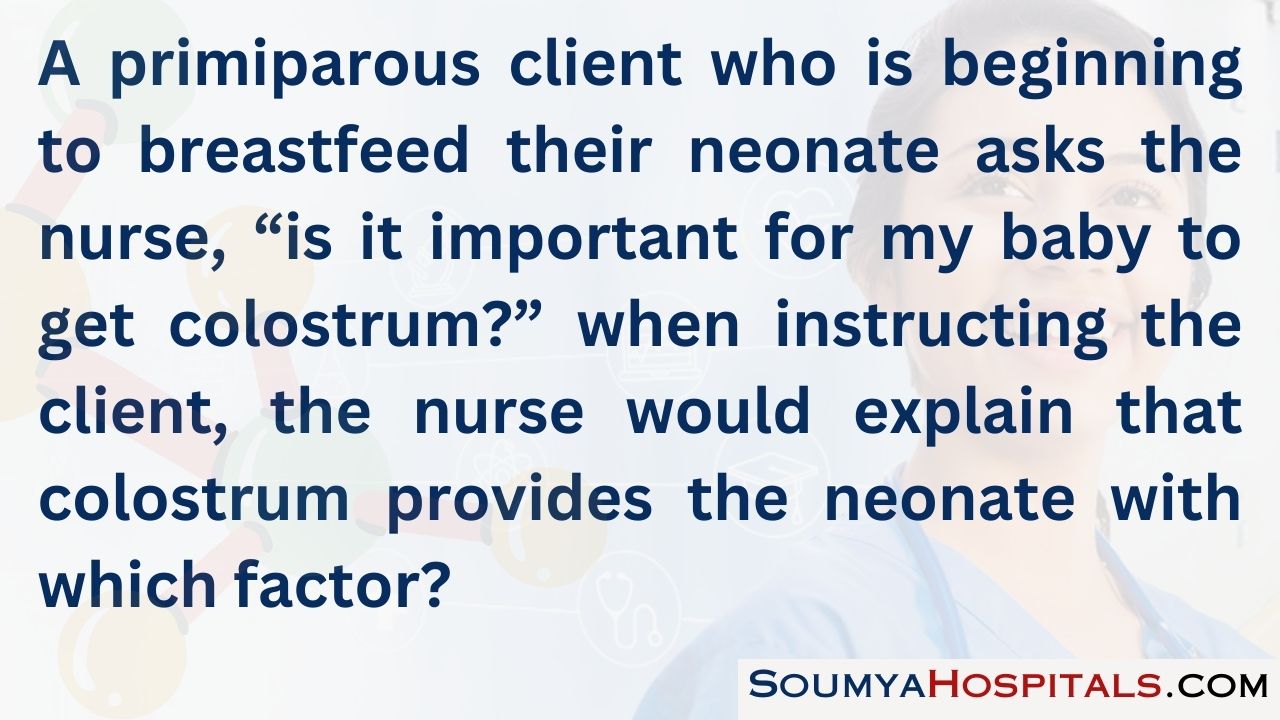
Explanation:
Colostrum is a thin, watery, yellow fluid composed of protein, sugar, fat, water, minerals, vitamins, and maternal antibodies (e.g., immunoglobulin A). It is important for the neonate to receive colostrum for passive immunity. Colostrum is lower in fat and lactose than mature breast milk. Colostrum does not contain vitamin K. The neonate will produce vitamin K once a feeding pattern is established. Colostrum may speed, rather than delay, the passage of meconium.
Question 47.
Which principle forms the basis for the teaching plan about avoiding nonprescription medication for a primiparous client who is breastfeeding?
(a) Breast milk quality and richness are decreased.
(b) The mother’s motivation to breastfeed is diminished.
(c) Medications may be excreted in breast milk to the nursing neonate.
(d) Medications interfere with the mother’s let-down reflex.
Answer:
(c) Medications may be excreted in breast milk to the nursing neonate.
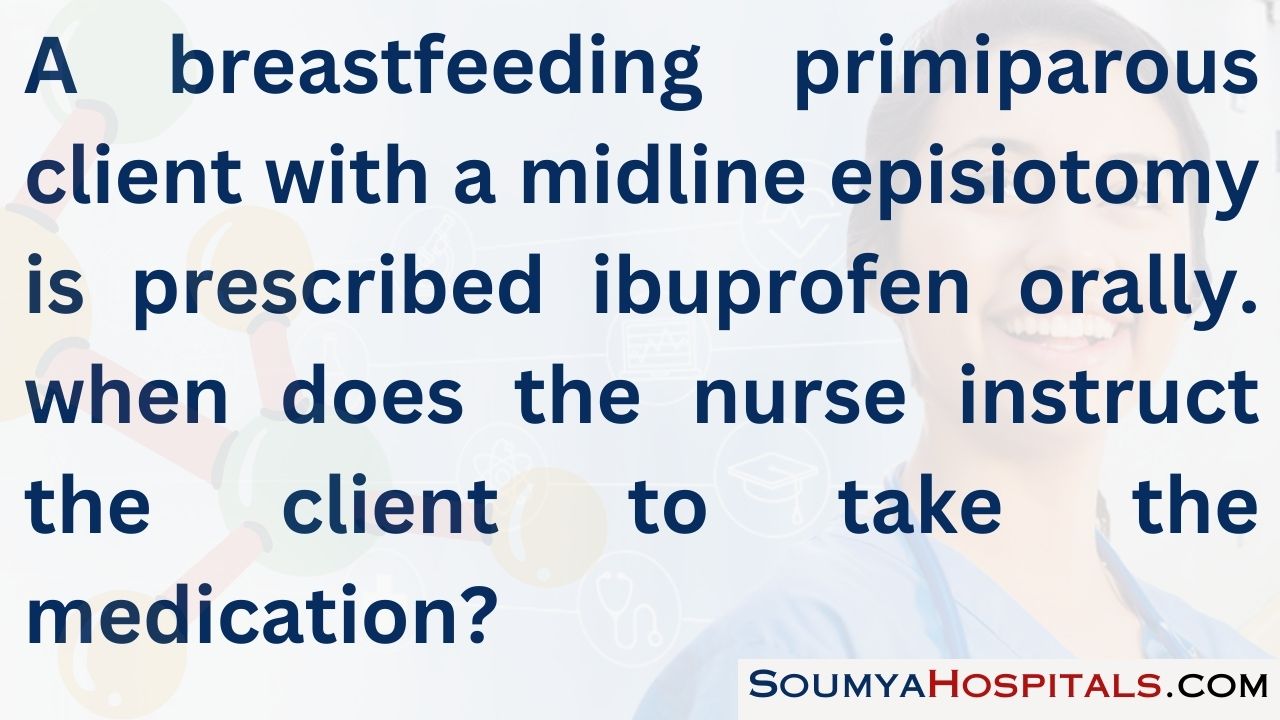
Explanation:
Various medications can be excreted in the breast milk and affect the nursing neonate. The client should avoid all nonprescribed medications (such as acetaminophen) unless approved by the health care provider (HCP) . Medications typically do not affect the quality of the mother’s breast milk. Medications usually do not interfere with or diminish the mother’s motivation to breastfeed, nor do they interfere with the mother’s letdown reflex.
Question 48.
A breastfeeding primiparous client with a midline episiotomy is prescribed ibuprofen orally. When does the nurse instruct the client to take the medication?
(a) before going to bed
(b) midway between feedings
(c) immediately after a feeding
(d) when providing a supplemental formula
Answer:
(c) immediately after a feeding
Explanation:
Taking ibuprofen 200 mg orally immediately after breastfeeding helps minimize the neonate’s exposure to the drug because drugs are most highly concentrated in the body soon after they are taken. Most mothers breastfeed on demand or every 2 to 3 hours, so the effects of the ibuprofen should be decreased by the next breastfeeding session.
Taking the medication before going to bed is inappropriate because, although the mother may go to bed at a certain time, the neonate may wish to breastfeed soon after the mother goes to bed. If the mother takes the medication midway between feedings, then its peak action may occur midway between feedings. Breast milk is sufficient for the neonate’s nutritional needs. Most breastfeeding mothers should not be encouraged to provide supplemental feedings to the infant because this may result in nipple confusion.
Question 49.
A multiparous client, 28 hours after cesarean birth, who is breastfeeding has severe cramps or afterpains. The nurse explains that these are caused by which factor?
(a) flatulence accumulation after a cesarean birth
(b) healing of the abdominal incision after cesarean birth
(c) adverse effects of the medications administered after birth
(d) release of oxytocin during the breastfeeding session
Answer:
(d) release of oxytocin during the breastfeeding session
Explanation:
Breastfeeding stimulates oxytocin secretion, which causes the uterine muscles to contract. These contractions account for the discomfort associated with afterpains. Flatulence may occur after a cesarean birth. However, the mother typically would have abdominal distention and a bloating feeling, not a “cramp-like” feeling. Stretching of the tissues or healing may cause slight tenderness or itching, not cramping feelings of discomfort. Medications such as mild analgesics or stool softeners, commonly administered postpartum, typically do not cause cramping.
Question 50.
After the nurse counsels a primiparous, breastfeeding client about diet and nutritional needs during the lactation period, which client statement indicates a need for additional teaching?
(a) “I need to increase my intake of vitamin D.”
(b) “I should drink at least five glasses of fluid daily. ”
(c) “I need to get an extra 500 cal/day.”
(d) “I need to make sure I have enough calcium in my diet.”
Answer:
(b) “I should drink at least five glasses of fluid daily. ”

Explanation:
For the breastfeeding client, drinking at least 8 to 10 glasses of fluid a day is recommended. Breastfeeding women need an increased intake of vitamin D for calcium absorption. A breastfeeding woman requires an extra 500 cal/day above the recommended nonpregnancy intake to produce quality breast milk. Breastfeeding women need adequate calcium for blood clotting and strong bones and teeth.
Question 51.
A breastfeeding primiparous client asks the nurse how breast milk differs from cow’s milk. The nurse responds by saying that breast milk is higher in which nutrient?
(a) fat
(b) iron
(c) sodium
(d) calcium
Answer:
(a) fat

Explanation:
Breast milk has a higher fat content than cow’s milk. Thirty to fifty-five percent of the calories in breast milk are from fat. Breast milk contains less iron than cow’s milk does. However, the iron absorption from breast milk is greater in the neonate than in cow’s milk. Breast milk contains less sodium and calcium than cow’s milk.
Question 52.
While assisting a primiparous client with her first breastfeeding session, the nurse should instruct the mother to perform which action in order to stimulate the neonate to open the mouth and grasp the nipple?
(a) Pull down gently on the neonate’s chin and insert the nipple.
(b) Squeeze both of the neonate’s cheeks simultaneously.
(c) Place the nipple into the neonate’s mouth on top of the tongue.
(d) Brush the neonate’s lips lightly with the nipple.
Answer:
(d) Brush the neonate’s lips lightly with the nipple.
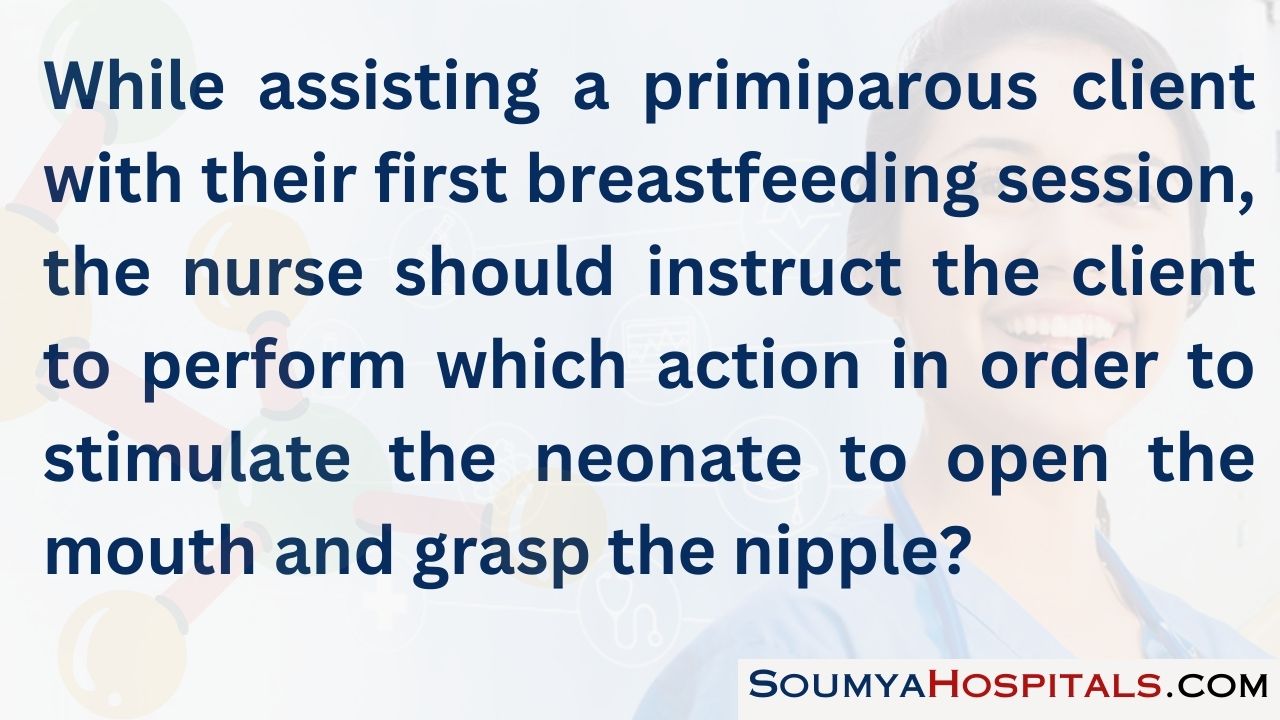
Explanation:
Lightly brushing the neonate’s lips with the nipple causes the neonate to open the mouth and begin sucking. The neonate should be taught to open the mouth and grasp the nipple on his or her own. The neonate should not be forced to nurse.
Question 53.
A 25-year-old primiparous client who gave birth 2 hours ago has decided to breastfeed her neonate. Which instructions should the nurse address as the highest priority in the teaching plan about preventing nipple soreness?
(a) keeping plastic liners in the brassiere to keep the nipple drier
(b) placing as much of the areola as possible into the baby’s mouth
(c) smoothly pulling the nipple out of the mouth after 10 minutes
(d) removing any remaining milk left on the nipple with a soft washcloth
Answer:
(b) placing as much of the areola as possible into the baby’s mouth
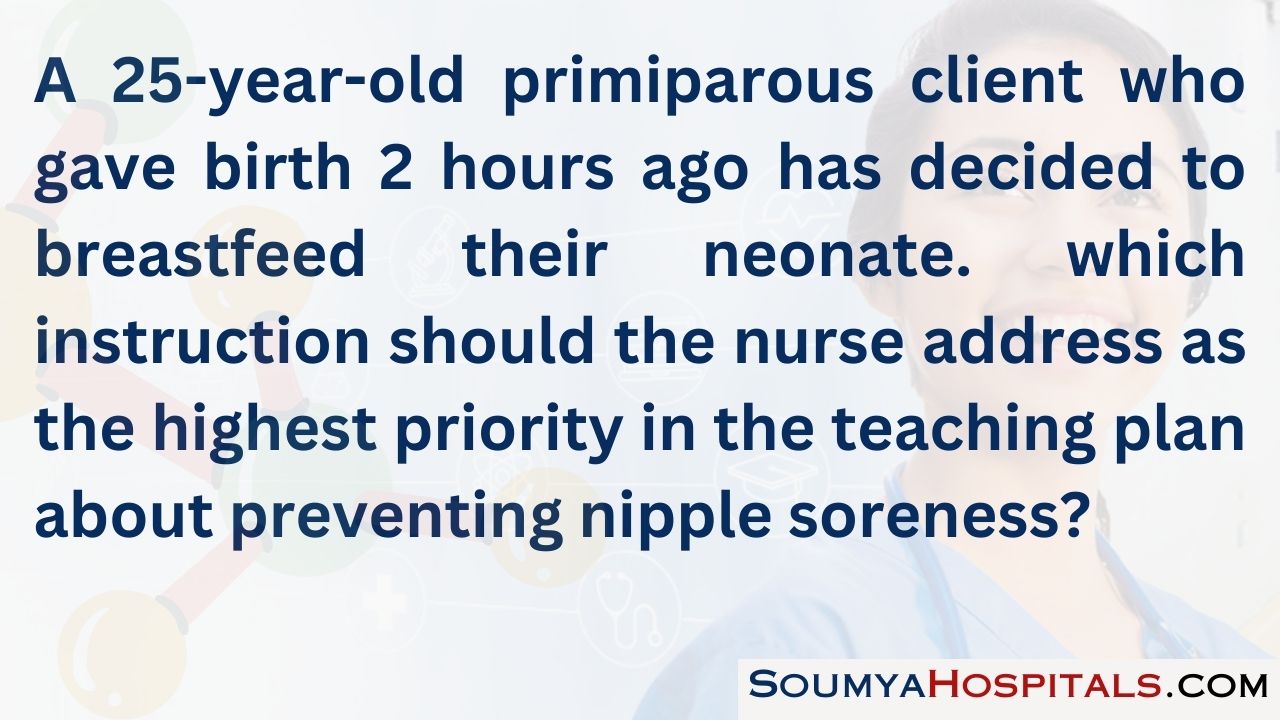
Explanation:
Several methods can be used to prevent nipple soreness. Placing as much of the areola as possible into the neonate’s mouth is one method. This action prevents compression of the nipple between the neonate’s gums, which can cause nipple soreness. Other methods include changing position with each feeding, avoiding breast engorgement, nursing more frequently, and feeding on demand.
Plastic liners are not helpful because they prevent air circulation, thus promoting nipple soreness. Instead, air drying is recommended. Pulling the baby’s mouth out smoothly after only 10 minutes may prevent the baby from getting the entire feeding and increase nipple soreness. Any breast milk remaining on the nipples should not be wiped off because the milk has healing properties.
Question 54.
Which client statement indicates effective teaching about burping a breastfed neonate?
(a) “Breastfed babies who are burped frequently will take more on each breast.”
(b) “If I supplement the baby with formula, I will rarely have to burp the baby.”
(c) “I will breastfeed my baby every 3 hours so I will not have to burp the baby.”
(d) “When I switch to the other breast, I will burp the baby.”
Answer:
(d) “When I switch to the other breast, I will burp the baby.”

Explanation:
Breastfed neonates do not swallow as much air as bottle-fed neonates, but they still need to be burped. Good times to burp the neonate are when the mother switches from one breast to the other and at the end of the breastfeeding session.
Neonates do not eat more if they are burped frequently. Breastfeeding mothers are advised not to supplement the feedings with formula because this may cause nipple confusion and decrease milk production. If supplements are given, the baby still needs to be burped. Neonates who are fed every 3 hours still need to be burped.
Question 55.
After the nurse teaches a primiparous client planning to return to work in 6 weeks about storing breast milk, which client statement indicates the need for further teaching?
(a) “I can safely store freshly expressed breast milk at room temperature for 8 hours.”
(b) “I will be sure to label the breast milk with the date, time, and amount.”
(c) “I must discard any breast milk stored for more than 3 days in the refrigerator.”
(d) “I can keep the breast milk in a deep freeze in clean glass bottles for up to 1 year.”
Answer:
(c) “I must discard any breast milk stored for more than 3 days in the refrigerator.”
Explanation:
While there is some variation in recommendations, fresh breast milk can be safely kept in the refrigerator for 5 to 7 days. Storage recommendations for frozen breast milk vary per type of freezer. In a chest or upright deep freezer at -4°F (-20°C) breast milk can be stored for 12 months. Breast milk should be stored in glass containers because immu-noglobulin tends to stick to plastic bottles.
Freshly expressed breast milk can remain without refrigeration or loss of nutrients for up to 6 to 8 hours. The containers should be labeled with date, time, and amount to prevent inadvertent administration of spoiled milk. Frozen breast milk should be thawed in the refrigerator for a few hours, placed under warm tap water, and then shaken.
Question 56.
During a home visit on the fourth post partum day, a primiparous client tells the nurse that she is aware of a “letdown sensation” in her breasts and asks what causes it. The nurse explains that the letdown sensation is stimulated by which hormone?
(a) progesterone
(b) estrogen
(c) prolactin
(d) oxytocin
Answer:
(d) oxytocin
Explanation:
Oxytocin stimulates the letdown reflex when milk is carried to the nipples. A lactating mother can experience the letdown reflex suddenly when she hears her baby cry or when she anticipates a feeding. Some mothers have reported feeling the letdown reflex just by thinking about the baby.
Progesterone plays an important role in pregnancy, but levels drop after giving birth. This hormone if taken for contraception too soon after birth may decrease milk supply. Estrogen influences development of female secondary sex characteristics and controls menstruation. Prolactin stimulates milk production.
Question 57.
During a home visit on the fourth postpartum day, a primiparous client tells the nurse that she has been experiencing breast engorgement. To relieve engorgement, the nurse teaches the client to use which intervention before nursing her baby?
(a) Apply an ice cube to the nipples.
(b) Rub the nipples gently with lanolin cream.
(c) Express a small amount of breast milk.
(d) Offer the neonate a small amount of formula.
Answer:
(c) Express a small amount of breast milk.
Explanation:
Expressing a little milk before nursing, massaging the breasts gently, or taking a warm shower before feeding also may help to improve milk flow. Although various measures such as ice, heat, and massage may be tried to relieve breast engorgement, prevention of breast engorgement by frequent feedings is the method of choice. Applying ice to the nipples does not relieve breast engorgement.
However, it may temporarily relieve the discomfort associated with breast engorgement. Using lanolin on the nipples does not relieve breast engorgement and is unnecessary. Use of lanolin may cause sensitivity and irritation. Having frequent breastfeeding sessions, rather than offering the neonate a small amount of formula, is the method of choice for preventing and relieving breast engorgement. In addition, offering the neonate small amounts of formula may result in nipple confusion.
Question 58.
A breastfeeding primiparous client who gave birth 8 hours ago asks the nurse, “How will I know that my baby is getting enough to eat?” Which guideline should the nurse include in the teaching plan as evidence of adequate intake?
(a) six to eight wet diapers by the 5th day
(b) three to four transitional stools on the 4th day
(c) ability to fall asleep easily after feeding on the first day
(d) regain of lost birth weight by the 3rd day
Answer:
(a) six to eight wet diapers by the 5th day
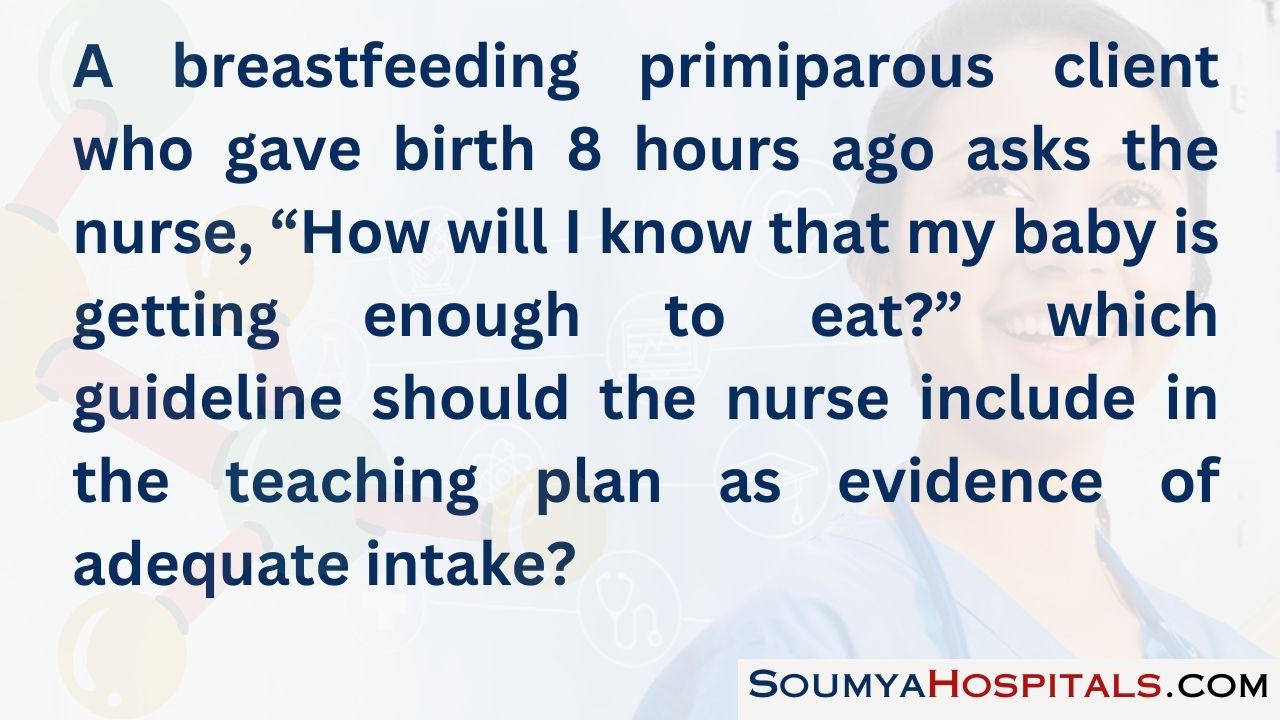
Explanation:
The nurse should instruct the client that the baby is getting enough to eat when there are six to eight wet diapers by the 5th day of age. Other signs include good suckling sounds during feeding, dripping breast milk at the mouth, and quiet rest or sleep after the feeding. By the 4th day of age, the infant should have soft yellow stools, not transitional (greenish) stools.
Falling asleep easily after feeding on the first day is not a good indicator because most infants are sleepy during the first 24 hours. Most infants regain their lost birth weight in 7 to 10 days after birth. An infant who has gained weight during the first well-baby checkup (usually at 2 weeks) is getting sufficient breast milk at feedings.

Question 59.
Which information should the nurse include in the teaching plan for a primiparous client who asks about weaning her neonate?
(a) “Wait until you have breastfed for at least 4 months.”
(b) “Eliminate the baby’s favorite feeding times first.”
(c) “Plan to omit the daytime feedings last.”
(d) “Gradually eliminate one feeding at a time.”
Answer:
(d) “Gradually eliminate one feeding at a time.”

Explanation:
The client should wean the infant gradually, eliminating one feeding at a time. The baby can be weaned to a bottle (formula) anytime the mother desires; she does not have to breastfeed for 4 months. Most infants (and mothers) develop a “favorite feeding time,” so this feeding session should be eliminated last. The client may wish to begin weaning with daytime feedings when the infant is busy.
Question 60.
A nurse is caring for a client who is 3 days postpartum and breastfeeding her baby. The following assessment is made by the nurse: episiotomy area: red and edematous; breasts: firm and tender on palpation; fundus: firm 2 fingerbreadths below the umbilicus. What nursing actions are indicated? Select all that apply.
(a) Suggest that the client apply a cool compress to the breasts.
(b) Encourage the client to sit on a supportive device.
(c) Ask the client how often the baby feeds.
(d) Suggest the client take cool sitz baths twice a day.
(e) Obtain specimen for culture and sensitivity from the episiotomy site.
Answer:
(c) Ask the client how often the baby feeds.
Explanation:
The client is experiencing symptoms of engorgement. Cool compresses between feedings can help decrease swelling. Determining when the baby last fed is critical as frequent feedings can help relieve symptoms. The nurse must also assess how long baby feeds, if it has a correct latch, and if baby empties breast during feeds. Sitting on supportive devices is not necessary as the episiotomy is healing.
Cool sitz baths do not promote circulation to the area; instead they cause vasoconstriction and decrease blood flow to the area, therefore prolonging healing and increasing discomfort. Swab for a culture and sensitivity is not warranted at this time. If edema and redness continue for more than 2 days then further assessment is required to rule out infection.
Question 61.
Two weeks after a breastfeeding primiparous client is discharged, she calls the birthing center and says that she is afraid she is “losing my breast milk. The baby had been nursing every 4 hours, but now she is crying to be fed every 2 hours.” The nurse interprets the neonate’s behavior as most likely caused by which factor?
(a) lack of adequate intake to meet maternal nutritional needs
(c) preventing the neonate from sucking long enough with each feeding
(d) the neonate’s temporary growth spurt, which requires more feedings
Answer:
(d) the neonate’s temporary growth spurt, which requires more feedings
Explanation:
Neonates normally increase breastfeeding during periods of rapid growth (growth spurts). These can be expected at age 10 to 14 days, 5 to 6 weeks, 2.5 to 3 months, and 4.5 to 6 months. Each growth spurt is usually followed by a regular feeding pattern. Lack of adequate intake to meet maternal nutritional needs is not associated with the neonate’s desire for more frequent breastfeeding sessions.
However, an intake of adequate calories is necessary to produce quality breast milk. The mother’s fears about weight gain and preventing the neonate from sucking long enough are not associated with the desire for more frequent breastfeeding sessions.
Question 62.
During a home visit to a breastfeeding primiparous client at 1 week postpartum, the client tells the nurse that her nipples have become sore and cracked from the feedings. Which instruction should the nurse give the client?
(a) Wipe off any lanolin creams from the nipple before each feeding.
(b) Position the baby with the entire areola in the baby’s mouth.
(c) Feed the baby less often for the next several days.
(d) Use a mild soap while in the shower to prevent an infection.
Answer:
(b) Position the baby with the entire areola in the baby’s mouth.
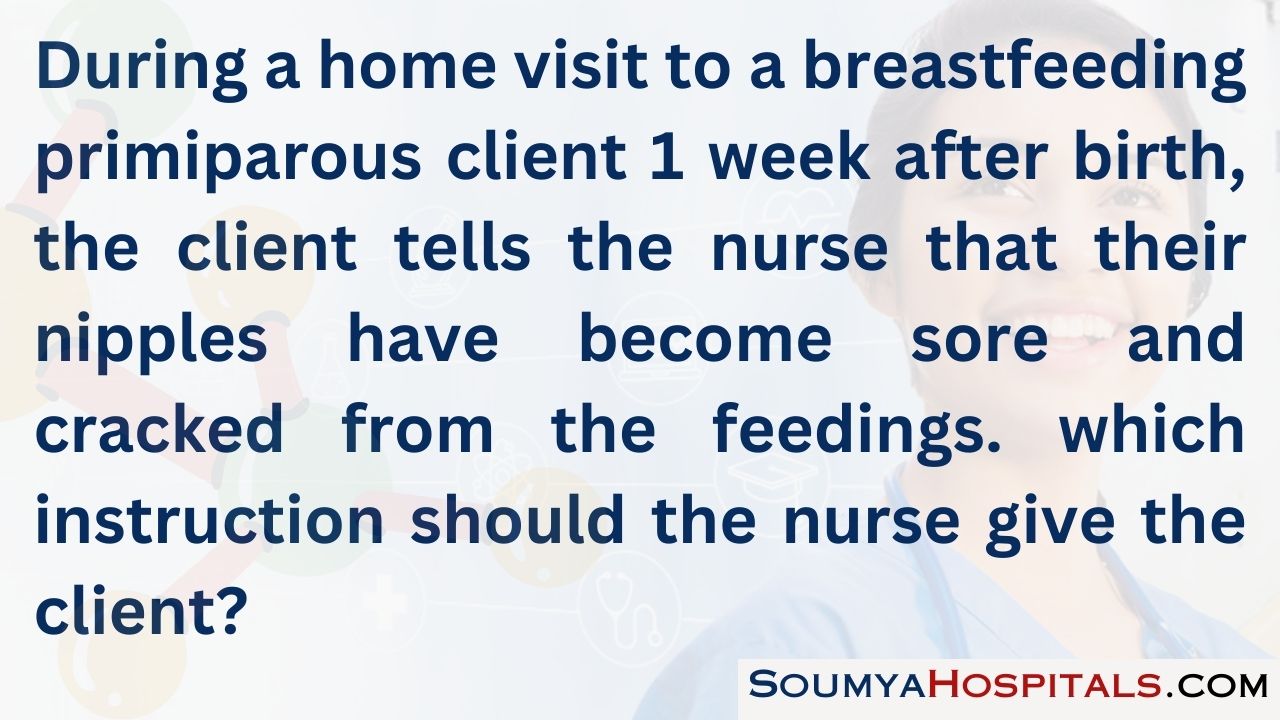
Explanation:
Even if the nipples are sore and cracked, the mother should position the baby with the entire areola in the baby’s mouth so that the nipple is not compressed between the baby’s gums during feeding. The best method is to prevent cracked nipples before they occur. This can be done by feeding frequently and using proper positioning. Warm, moist tea bags can soothe cracked nipples because of the tannic acid in the tea.
Creams on the nipples should be avoided; wiping off any lanolin creams from the nipple before each feeding can cause further soreness. Feeding the baby less often for the next few days will cause engorgement (and possible neonatal weight loss), leading to additional problems. Soap use while in the shower should be avoided to prevent drying and removal of protective oils.
Question 63.
A new father indicates he feels left out of the new family relationship since he is not able to bond the same way as the breastfeeding mother. What is the most appropriate response by the nurse?
(a) “This is normal, and these feelings will go away within a few days.”
(b) “Holding, talking to, and playing with the infant will facilitate bonding between baby and Dad.”
(c) "Bonding occurs later in the first year of life, and Dad can become involved when the infant is better able to recognize him.”
(d) “Maternal infant bonding takes priority over paternal infant bonding.”
Answer:
(b) “Holding, talking to, and playing with the infant will facilitate bonding between baby and Dad.”
Explanation:
Time for bonding with their newborns is a frequent concern for fathers of breastfed babies. It is common for fathers to express concern about having less intimate contact time. These feelings are normal, but they do not go away in a few days. The father of the baby has to dedicate time to spend with the infant where he can talk to, hold, cuddle, and/or play with the infant.
These strategies provide the infant with the contact and stimulation to establish a close bond between them. Bonding occurs from the moment of birth and continues in various ways between mother, father, and infant. Infants recognize and respond to touch, light, and voice immediately after birth. Bonding between both parents is equally important, and one does not take priority over the other.
Question 64.
The triage nurse in the pediatrician’s office returns a call to a mother who is breastfeeding her 4-day-old infant. The mother is concerned about the yellow seedy stool that has developed since discharge home. What is the best reply by the nurse?
(a) “This type of stool indicates the infant may have diarrhea and should be seen in the office today.”
(b) “The stool will transition into a soft, brown, formed stool within a few days and is appropriate for breastfeeding.”
(c) “The stool results from the gassy food eaten by the mother. Refrain from eating these foods while breastfeeding.”
(d) “Soft, seedy, unformed stools with each feeding are normal for this age infant and will continue through breastfeeding.”
Answer:
(d) “Soft, seedy, unformed stools with each feeding are normal for this age infant and will continue through breastfeeding.”
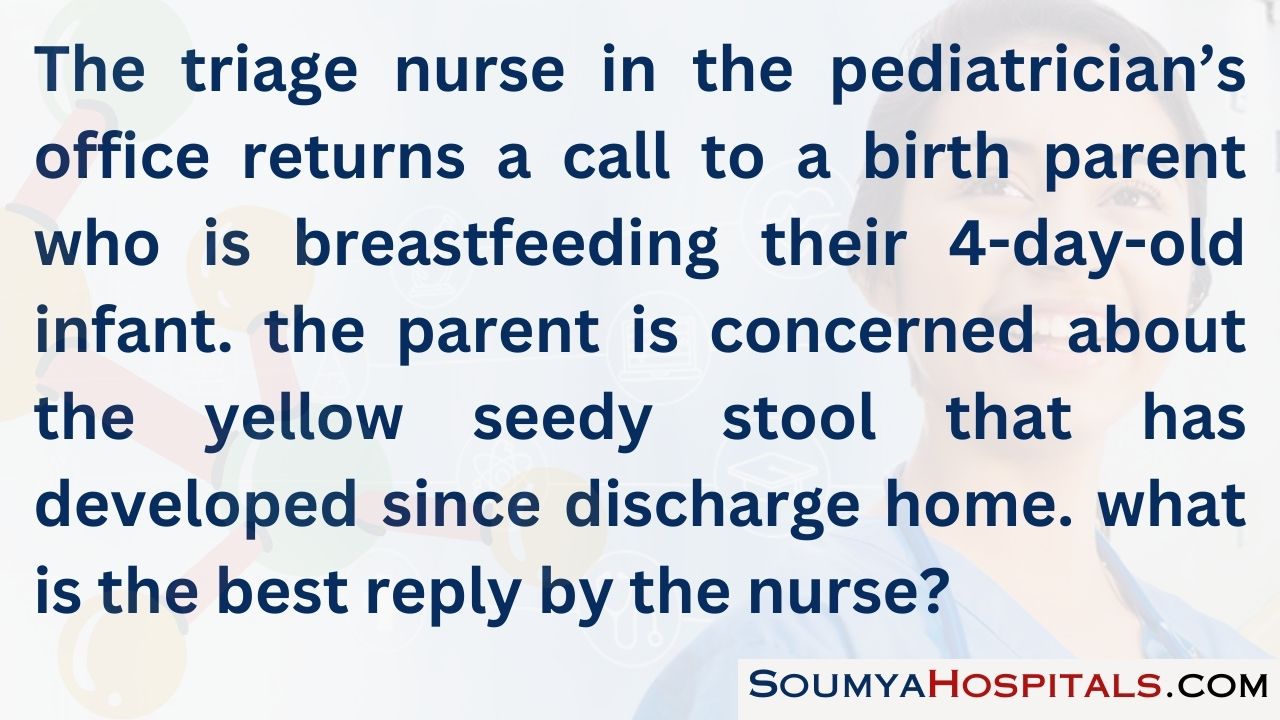
Explanation:
A soft seedy unformed stool is the norm for a 4-day-old infant. It may surprise the mother as it is a change from the meconium the infant had since birth. This stool is not diarrhea even though it has no form. There is no need for the infant to be seen for this. As long as the infant is breastfeeding, the stools will remain of this color and consistency. Brown and formed stool is common for an infant who is bottle-fed or after the breastfeeding infant has begun eating food.
Question 65.
The nurse is assessing a client at her postpartum checkup 6 weeks after a vaginal birth. The mother is bottle-feeding her baby. Which client finding indicates a problem at this time?
(a) firm fundus at the symphysis
(b) menstrual discharge
(c) striae that are silver in color
(d) soft breasts without milk
Answer:
(a) firm fundus at the symphysis
Explanation:
By 4 to 6 weeks postpartum, the fundus should be deep in the pelvis and the size of a non pregnant uterus. Subinvolution, caused by infection or retained placental fragments, is a problem associated with a uterus that is larger than expected at this time. Menstruation can normally return after 6 to 8 weeks in nonbreastfeeding clients. Other normal expectations include striae that are beginning to fade to silver and breasts that are soft without evidence of milk production (in a bottle-feeding mother).
Question 66.
A client gave birth 2 days ago and has been given instructions on breast care for bottle-feeding mothers. Which statement indicates that the nurse should reinforce the instructions to the client?
(a) “I will wear a sports bra or a well-fitting bra for several days."
(b) ‘‘When showering, I will direct water onto my shoulders.”
(c) ‘‘I will use only water to clean my nipples.”
(d) "I will use a breast pump to remove any milk that may appear.”
Answer:
(d) "I will use a breast pump to remove any milk that may appear.”
Explanation:
The use of a breast pump to remove milk is contraindicated in bottle-feeding mothers. Nipple and breast stimulation and emptying of the breasts produce milk, rather than eliminate milk production. The bottle-feeding client is discouraged from stimulating the breasts in any way.
A sports bra that is well fitting provides support and decreases stimulation. (Binders are not suggested.) Having the water in a shower land on the shoulders of the mother rather than the breasts also decreases stimulation. Only water is necessary to clean nipples when breast or bottle-feeding.
Question 67.
A 24-year-old primipara who has given birth to a healthy neonate plans to bottle-feed her neonate. What information regarding normal weight gain should the nurse include in the teaching plan?
(a) A baby normally loses 15% of weight before beginning to gain weight.
(b) Adding rice cereal to the bottle is a good way to increase calories if weight gain is slow.
(c) Gaining 30 g/day is a normal weight gain pattern.
(d) Babies typically double birth weight by 3 months.
Answer:
(c) Gaining 30 g/day is a normal weight gain pattern.
Explanation:
Gaining 1 oz (30 g) a day is normal for a neonate. Initial weight loss that exceeds 10% of birth weight is abnormal. Adding rice cereal to a bottle without a medical indication increases the risk of aspiration and may promote obesity. Doubling the birth weight is typical at 5 months.
Question 68.
A primiparous client with a neonate who is 36 hours old asks the nurse, “Why does my baby spit up a small amount of formula after feeding?” The nurse explains that the regurgitation is thought to result from which factor?
(a) an immature cardiac sphincter
(b) a defect in the gastrointestinal system
(c) burping the infant too frequently
(d) moving the infant during the feeding
Answer:
(a) an immature cardiac sphincter

Explanation:
Initial regurgitation in the neonate during the first 12 to 24 hours may be caused by excessive mucus and gastric irritation from foreign substances in the stomach. After the first 24 hours, regurgitation is thought to be caused by the neonate’s immature cardiac sphincter. It represents an overflow of stomach contents and is probably a result of feeding the neonate too fast or too much.
A defect in the gastrointestinal system usually results in more severe symptoms. A small amount of regurgitation is normal, but vomiting or forceful fluid expulsion is not. Burping the infant often during feeding can decrease the amount of air in the stomach from swallowing. However, burping too often can lead the neonate to become tired or fussy. Moving the infant usually does not result in regurgitation.
Question 69.
A primiparous client who will be bottle-feeding her neonate asks, “What is the best position for the baby to nap after feeding?” Which position should the nurse recommend?
(a) supine position
(b) on the left side
(c) prone without a pillow
(d) upright on the caregiver’s lap
Answer:
(a) supine position
Explanation:
The neonate should be placed in a supine position. Placing infants on their side or prone in a crib after a feeding is no longer recommended due to the increased risk of sudden infant death syndrome (SIDS). Although the mother may desire to hold the infant in her lap after feeding, this is not necessary for the neonate’s digestion unless the infant has reflux.
Question 70.
A primiparous client who is bottle-feeding her neonate asks, “When should I start giving the baby solid foods?” The nurse instructs the client to introduce solid foods no sooner than at which age?
(a) 2 months
(b) 6 months
(c) 8 months
(d) 10 months
Answer:
(b) 6 months

Explanation:
Pediatricians recommend that infants be given either breast milk or formula until at least 6 months of age because of the neonate’s difficulty digesting solid foods. Giving solid foods too early can lead to food allergies. Because chewing movements do not begin until 7 to 9 months of age, foods requiring chewing should be delayed until this time.
Question 71.
After instructing a primiparous client who is bottle-feeding about burping, which client statement indicates that the client needs further teaching?
(a) “I will burp him after 15 minutes of feeding him formula.”
(b) “After he takes one-half ounce of formula, I will burp him."
(c) “I will burp him while he is in an upright position."
(d) “I will gently pat his back to get him to burp.”
Answer:
(a) “I will burp him after 15 minutes of feeding him formula.”
Explanation:
The client needs further instruction when she says burping should be done after 15 minutes of formula feeding. The entire feeding should take only 15 to 20 minutes, and the neonate should be burped before the feeding is complete. During initial feedings, the burping should be done after each halfounce of formula with the neonate in an upright position, patting the neonate gently on the back.
Question 72 .
When teaching a primiparous client about the growth and development of the neonate, the nurse should explain that most babies are able to drink from a sippy cup at what age?
(a) 5 to 7 months
(b) 8 to 10 months
(c) 12 to 14 months
(d) 15 to 16 months
Answer:
(b) 8 to 10 months
Explanation:
Most babies are developmentally ready to drink from a cup by the age of 8 to 10 months. If the child has not mastered drinking from a cup by this time, there may be a problem with motor development that requires further investigation.
Question 73.
The nurse reviews the contraception choices of a bottle-feeding postpartum client prior to discharge. The client wants to know why she needs to wait to resume the use of oral contraceptives. What is the nurse’s best response?
(a) “The estrogen in combined hormonal contraceptives interferes with the involution process."
(b) “Clients cannot resume intercourse for 6 weeks after birth, so contraception is not needed."
(c) “Combined oral contraceptives potentiate the risk for blood clots immediately after birth.”
(d) “The risk for bleeding is increased from the progestin in combined hormonal contraceptives. “
Answer:
(c) “Combined oral contraceptives potentiate the risk for blood clots immediately after birth.”
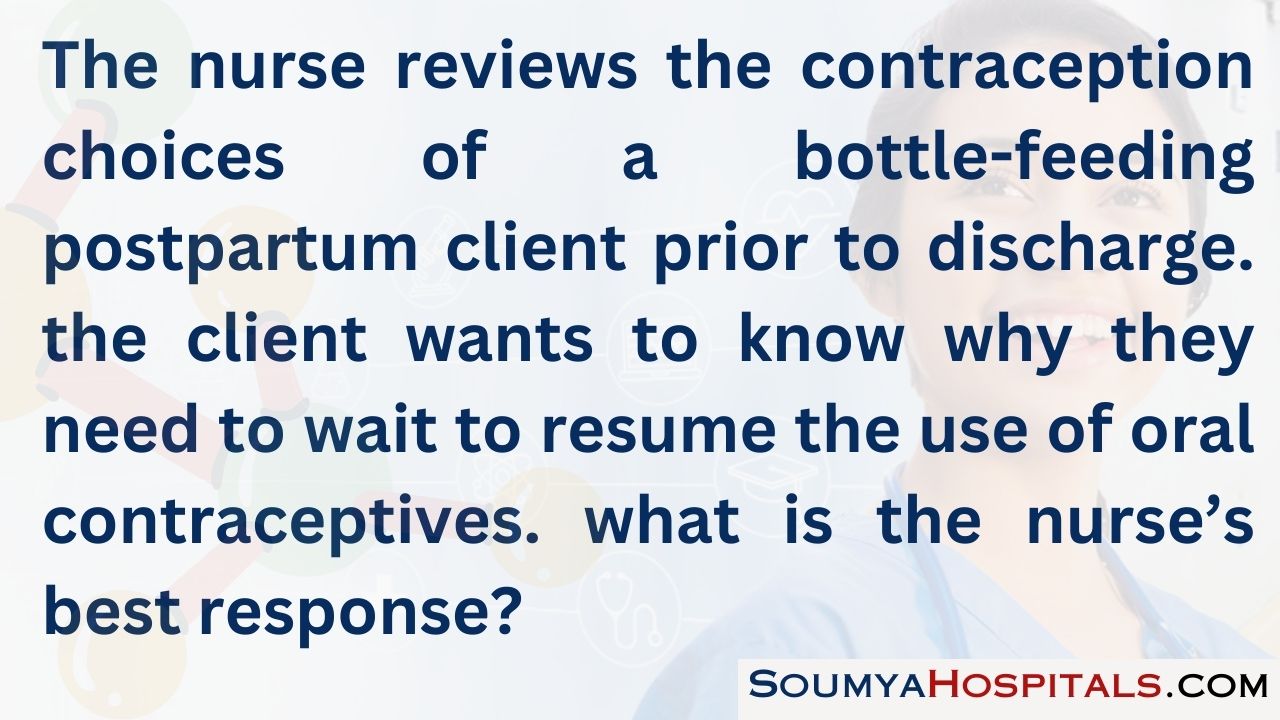
Explanation:
Pregnancy and the immediate postpartum period is a hypercoagulable state that puts clients at risk for blood clots. Taking a combined hormonal contraceptive would expose the client to estrogen and further increase the risk of blood clots. Clients are advised to wait a minimum of 3 weeks after birth before taking estrogen-containing contraceptives.
Oral contraceptives do not significantly affect the involution process in nonbreastfeeding women. For oral contraceptives to be effective, they must be started before intercourse resumes. While some practitioners may advise clients to wait 6 weeks before resuming intercourse, other providers advise clients that they may resume after they no longer have lochia. Progestin does not significantly increase the risk for bleeding after birth, and there are no restrictions for beginning progestin-based contraceptives in nonbreastfeeding women.
Question 74.
The nurse places inflatable compression sleeves on the legs of a client undergoing a cesarean birth under a regional anesthetic. When does the nurse tell the client that the sleeves will be removed?
(a) after the sensation returns to the lower extremities
(b) when the platelet levels return to normal
(c) when the client resumes ambulating
(d) just prior to the client’s discharge
Answer:
(c) when the client resumes ambulating

Explanation:
A cesarean birth is an independent risk factor for thromboembolic events in pregnant women. Inflatable compression sleeves should be placed on the lower extremities of a client until the risk of venous stasis is reduced through ambulation. While a return of sensation must happen before the client can safely ambulate, this finding alone does not significantly decrease the risk of venous stasis.
Platelets continue to be significantly elevated for at least 3 weeks after birth, which is well after a client is discharged. It is unnecessary to continue wearing the compression sleeves after ambulation has returned.
Question 75.
The nurse is assessing a client who had a cesarean birth 12 hours ago. Findings include a distended abdomen with faint bowel sounds x 1 quadrant, fundus firm at the umbilicus, lochia scant, rubra, and pain rated 2 on a scale of 1 to 10. The IV and Foley catheter have been discontinued, and the client received medication 3 hours ago for pain. The client can have pain medication every 3 to 4 hours. What should the nurse do first?
(a) Give the client pain medication.
(b) Flave the client to use the incentive spirometry.
(c) Ambulate the client from the bed to the hallway and back.
(d) Encourage the client to begin caring for her baby.
Answer:
(c) Ambulate the client from the bed to the hallway and back.
Explanation:
The client should have more active bowel sounds by this time postpartum. Ambulation will encourage passing flatus and begin peristaltic action in the gastrointestinal track. Medicating the client should be evaluated prior to ambulating, but it is probably too soon because the last dose was 3 hours ago and her pain assessment rating is fairly low.
Pain medications should not have codeine as a component as it decreases peristaltic activity. Incentive spirometry or asking the client to turn, cough, and deep breathe is appropriate to encourage good oxygen exchange in the lungs prior to ambulation, and walking can be used concurrently with these interventions. Participating in infant care is another way to encourage the mother to move about, but the primary goal would be to have her walk on the unit, a more purposeful activity.
Question 76.
Carboprost was injected into the uterus of a client to treat uterine atony during a cesarean birth. In preparing to care for this client postpartum, the nurse should assess the client for which common adverse effects of the medication?
(a) vertigo and confusion
(b) nausea and diarrhea
(c) restlessness and increased vaginal bleeding
(d) headache and hypertension
Answer:
(b) nausea and diarrhea
Explanation:
Carboprost is an oxytocic prostaglandin that causes uterine contraction in women who are bleeding heavily. Nausea, vomiting, diarrhea, and fever are common adverse effects of prostaglandin administration. Vertigo and confusion are not associated with this drug.
Carboprost may not control all cases of hemorrhage, but it does not cause bleeding. Restlessness typically is a sign of shock, not a reaction to carboprost. If too large a dose is given, the client may experience headache and hypertension because carboprost contracts smooth muscles.
Question 77.
A multigravida 30-year-old woman has given cesarean birth to a healthy term neonate due to an abnormal fetal heart rate tracing. At 2 hours postpartum, the nurse assesses the client’s urinary catheter and observes that the client’s urine is slightly red-tinged. What should the nurse do next?
(a) Continue to monitor the client’s input and output.
(b) Palpate the client’s fundus gently every 15 minutes.
(c) Assess the placement of the Foley catheter.
(d) Contact the client’s health care provider (HCP) for further instructions.
Answer:
(d) Contact the client’s health care provider (HCP) for further instructions.
Explanation:
Slightly red-tinged urine may indicate that the bladder was accidentally cut during the cesarean birth. The nurse should notify the HCP as soon as possible about the urine color. Continuing to monitor the client’s input and output should be done after the HCP is contacted.
Palpating the fundus every 15 minutes is not necessary unless the client’s fundus becomes soft or “boggy.” Assessment of the urinary catheter is a normal part of the elimination assessment by the nurse, but displacement is not the cause of the red-tinged urine.
Question 78.
Four hours after cesarean birth of a neonate weighing 8 lb, 13 oz (4,000 g), the primiparous client asks, “If I get pregnant again, will I need to have a cesarean?” When responding to the client, the nurse should base the response to the client about vaginal birth after cesarean (VBAC) on which standard of practice?
(a) VBAC may be possible if the client has not had a classic uterine incision.
(b) A history of rapid labor is a necessary criterion for VBAC.
(c) A low transverse incision contraindicates the possibility for VBAC.
(d) VBAC is not possible because the neonate was large for gestational age.
Answer:
(a) VBAC may be possible if the client has not had a classic uterine incision.
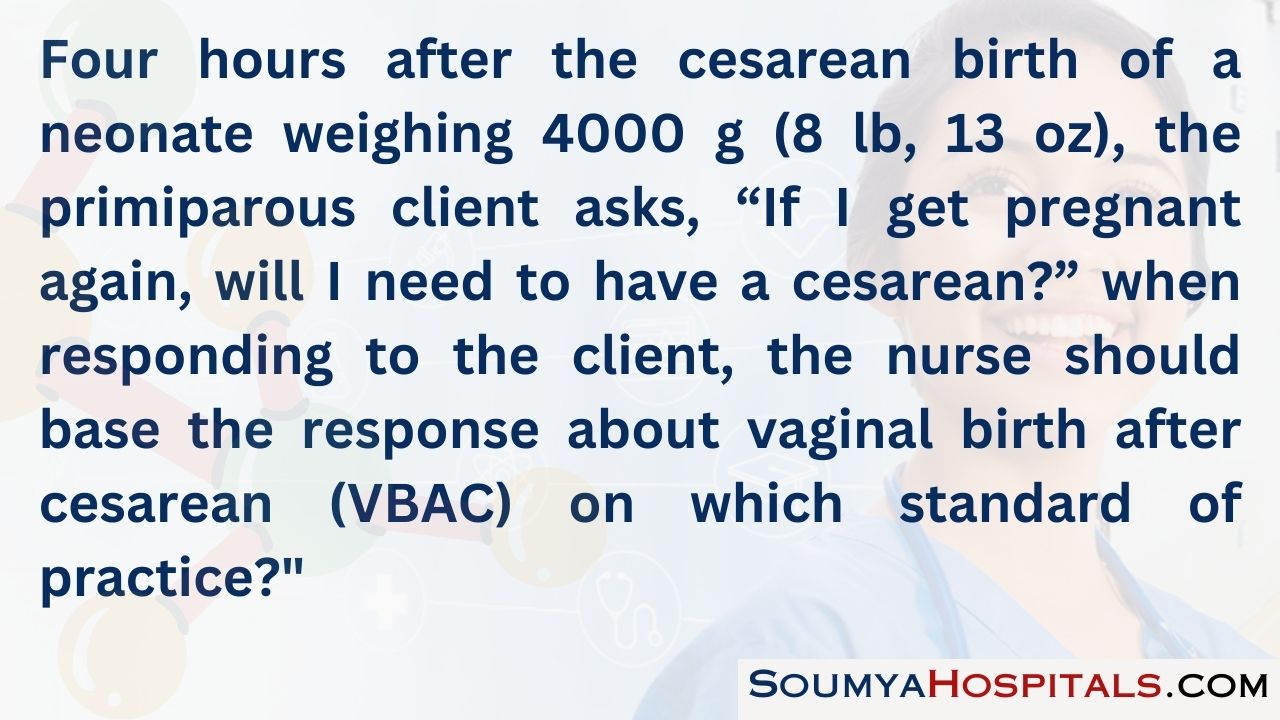
Explanation:
VBAC can be attempted if the client has not had a classic uterine incision. This type of incision carries a danger of uterine rupture. A healthcare provider (HCP) must be available, and a cesarean birth must be possible within 30 minutes.
A history of rapid labor is not a criterion for VBAC. A low transverse incision is not a contraindication for VBAC. A classic (vertical) incision is a contraindication because the client has a greater possibility of uterine rupture. Estimated fetal weight > 4,000 g by itself is not a contraindication if the mother is not diabetic.
Question 79.
A primiparous client who underwent a cesarean birth 30 minutes ago is to receive Rho(D) immune globulin. The nurse should administer the medication within which time frame after birth?
(a) 12 hours
(b) 24 hours
(c) 48 hours
(d) 72 hours
Answer:
(d) 72 hours

Explanation:
For maximum effectiveness, Rho(D) immune globulin should be administered within 72 hours postpartum. Most Rh-negative clients also receive Rho(D) immune globulin during the prenatal period at 28 weeks’ gestation and then again after birth.
The drug is given to Rh-negative mothers who have a negative Coombs test and give birth to Rh-positive neonates. If there is doubt about the fetus’s blood type after the pregnancy is terminated, the mother should receive the medication.
Question 80.
While the nurse is caring for a primiparous client with cephalopelvic disproportion 4 hours after a cesarean birth, the client requests assistance in breastfeeding. To promote maximum maternal comfort, which position would be most appropriate for the nurse to suggest?
(a) cesarean birth
(b) scissors hold
(c) cross-cradle hold
(d) cradle hold
Answer:
(a) cesarean birth
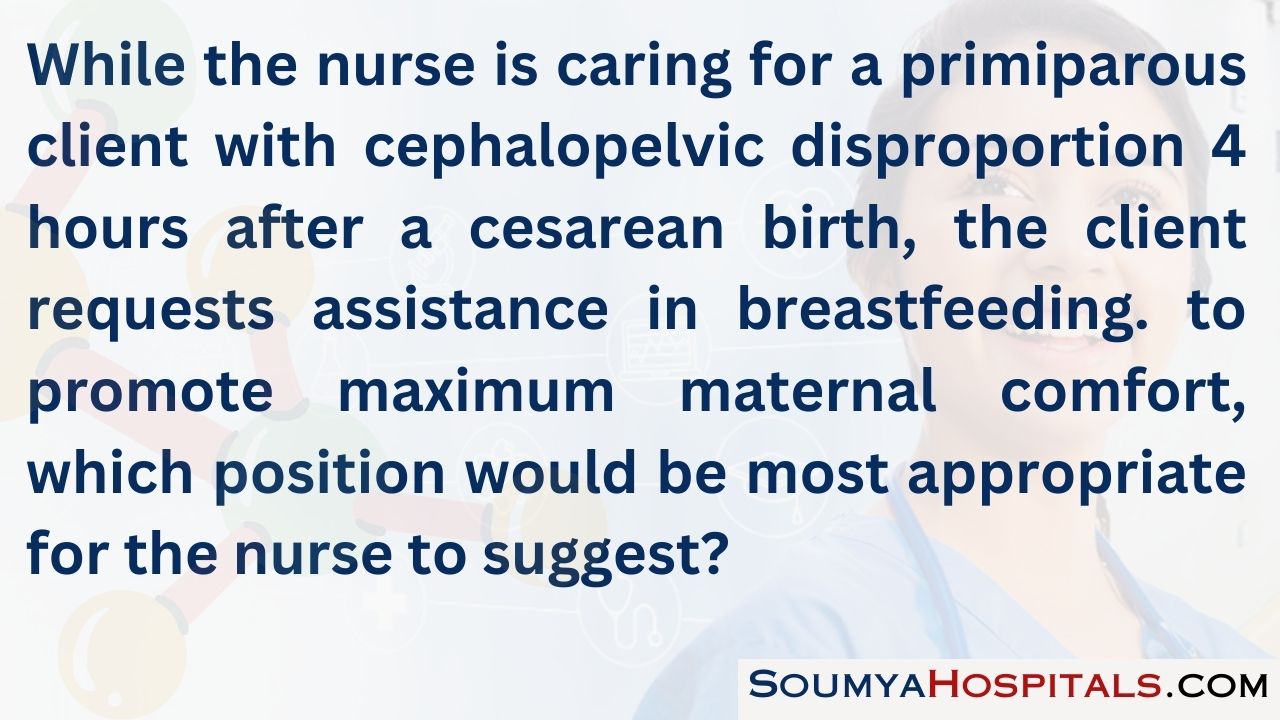
Explanation:
After a cesarean birth, most mothers have the greatest comfort when the neonate is positioned in the football hold with the mother in a semi-Fowler’s position, supporting the neonate’s head in her hand and resting the neonate’s body on pillows alongside her hip. This position prevents pressure on the uterine incision yet allows the neonate easy access to the mother’s breast. The scissors hold, where the mother places her hand well back on the breast to prevent touching the areola and interfering with the neonate’s mouth placement, is used by the mother to hold the breast and support it during breastfeeding.
The cross-cradle hold is done when the mother holds the neonate’s head in the hand opposite from the breast on which the neonate will feed and the mother’s arm supports the neonate’s body across her lap. This position can be uncomfortable because of the pressure placed on the client’s incision line. For the cradle hold, the mother cradles the infant alongside the arm at the breast on which the neonate will feed. This position also can be uncomfortable because of the pressure placed on the incision line.
Question 81.
A multigravid client gave birth vaginally 2 hours ago. A family member notifies the nurse that the client is pale and shaky. Which are the priority assessments for the nurse to make?
(a) blood glucose and vital signs
(b) temperature and level of consciousness
(c) uterine infection and pain
(d) fundus and lochia
Answer:
(d) fundus and lochia
Explanation:
A client who is pale and shaking could be experiencing hypovolemic shock likely caused by blood loss. A primary cause of blood loss after the birth of an infant is uterine atony. Therefore, the priority assessment should be the fundus of the uterus for firmness and location. In addition, the amount of vaginal bleeding (lochia) should also be assessed. An immediate intervention for uterine atony is fundal massage that will help the uterus to contract and therefore stop additional bleeding.
Assessing the client’s level of consciousness does not require additional time and can be done by the nurse while the fundus and lochia are assessed. Obtaining vital signs, blood glucose, and temperature are important but either should be done after the fundus has been assessed and massaged or should be obtained by a second responder. Assessing for uterine infection and pain should be done after treatment for hypovolemic shock has been initiated.
Question 82.
A postpartum woman has unrelenting pain in her rectum after vaginal birth despite administration of pain medications. Which action is most indicated?
(a) administering additional pain medications
(b) assessing the perineum
(c) reassuring the client that pain is normal after vaginal birth
(d) preparing a warm sitz bath for the client
Answer:
(b) assessing the perineum

Explanation:
Pain after birth is generally well managed with pain control medications; since they did not help this woman, further assessment is necessary. The first nursing action would be to assess the source of the pain; the woman may have sustained a laceration or a hematoma as a result of birth.
Assessing the perineum may help the nurse to determine the source of the pain and may require follow-up by the health care provider (HCP). Subsequent nursing interventions may include pain medication, sitz bath, or education regarding the healing process.
Question 83.
A multiparous client at 24 hours postpartum is found to have swelling and pain in her right leg. She demonstrates a positive Homans sign with discomfort. What should the nurse do next?
(a) Place a cold pack on the client’s perineal area.
(b) Place the client in semi-Fowler’s position.
(c) Notify the client’s health care provider (HCP) immediately.
(d) Ask the client to ambulate around the room.
Answer:
(c) Notify the client’s health care provider (HCP) immediately.
Explanation:
A pain and swelling may be indicative of thrombophlebitis. Redness at the site and may be more reliable as an indicator of thrombophlebitis. The nurse should notify the HCP immediately and ask the client to remain in bed to minimize the risk for pulmonary embolus, a serious consequence of throm bophlebitis should a clot dislodge. Placing an ice pack on the perineal area is inappropriate.
However, ice to the perineum would be useful for episiotomy pain and swelling. The client does not need to be positioned in a semi-Fowler’s position but should remain on bed rest to prevent the dislodgement of a potential clot.
Question 84.
Prophylactic heparin therapy is prescribed to treat thrombophlebitis in a multiparous client who gave birth 24 hours ago. After instructing the client about the medication, the nurse determines that the client understands the instructions when she states which effect is the purpose of the drug?
(a) to thin the blood clots
(b) to increase the lochial flow
(c) to increase the perspiration for diuresis
(d) to prevent further blood clot formation
Answer:
(d) to prevent further blood clot formation
Explanation:
Heparin therapy is prescribed to prevent further clot formation by inhibiting further thrombus and clot formation. Heparin, an anticoagulant, does not make blood clots thinner. An adverse effect of heparin therapy during the puerperium is increased lochia flow, so the nurse must be observant for symptoms of hemorrhage, such as heavy lochial flow. Heparin does not increase diaphoresis, which is normal for the postpartum client.
Question 85.
While caring for a postpartum client who is receiving treatment with bed rest and intravenous heparin therapy for a deep vein thrombosis, the nurse should contact the client’s health care provider (HCP) immediately if the client exhibits which symptom?
(a) pain in her calf
(b) dyspnea
(c) hypertension
(d) bradycardia
Answer:
(b) dyspnea
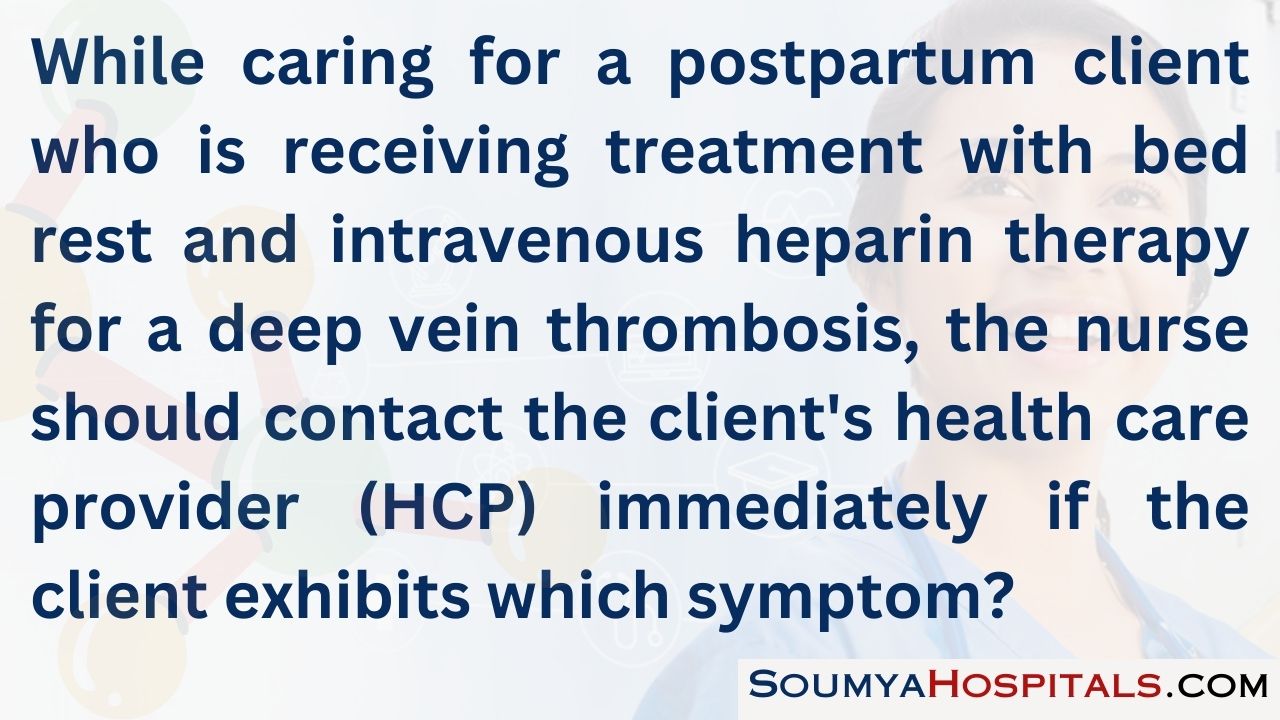
Explanation:
A major complication of deep vein thrombosis is pulmonary embolism. Signs and symptoms, which may occur suddenly and require immediate treatment, include dyspnea, severe chest pain, apprehension, cough (possibly accompanied by hemoptysis), tachycardia, fever, hypotension, diaphoresis, pallor, shortness of breath, and friction rub.
Pain in the calf is common with a diagnosis of deep vein thrombosis. Hypotension, not hypertension, would suggest a possible pulmonary embolism. It also could suggest possible hemorrhage secondary to intravenous heparin therapy. Bradycardia for the first 7 days in the postpartum period is normal.
Question 86.
A primiparous client 3 days postpartum is to be discharged on heparin therapy. After teaching her about the possible adverse effects of heparin therapy, the nurse determines that the client needs further instruction when she states that the adverse effects include which symptom?
(a) epistaxis
(b) bleeding gums
(c) slow pulse
(d) petechiae
Answer:
(c) slow pulse
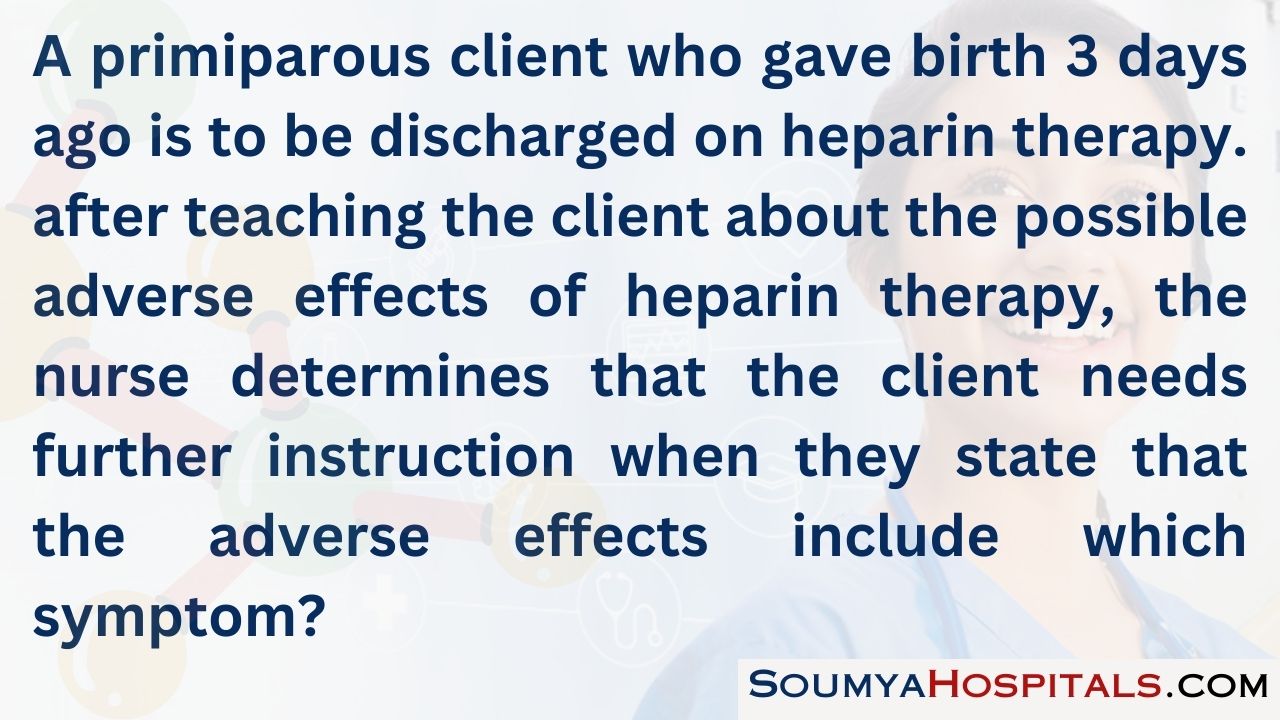
Explanation:
A slow pulse (bradycardia) is normal for the first 7 days postpartum as the body begins to adjust to the decrease in blood volume and return to the prepregnant state. Adverse effects of heparin therapy suggesting prolonged bleeding include hematuria, epistaxis, increased lochial flow, and bleeding gums. Typically, tachycardia, not
bradycardia, would be associated with hemorrhage. Petechiae indicate bleeding under the skin or in subcutaneous tissue.
Question 87.
After being treated with heparin therapy for thrombophlebitis, a multiparous client who gave birth 4 days ago is to be discharged on oral warfarin. After the nurse teaches the client about the medication and its possible effects, which client statement indicates successful teaching?
(a) “I can take ibuprofen if I get uterine cramps.”
(b) “I will need my INR drawn every week.”
(c) “I should use only waxed dental floss when caring for my teeth.”
(d) “I need to refrain from eating green leafy vegetables.”
Answer:
(c) “I should use only waxed dental floss when caring for my teeth.”
Explanation:
Anticoagulant therapy can cause the gums to bleed, so a soft toothbrush and waxed dental floss should be used to minimize this adverse effect. The use of nonsteroidal anti-inflammatory medications should be avoided because of the increased risk for possible hemorrhage. Clients will need frequent INRs at the beginning of treatment which could be more often than weekly.
Once IRN levels have stabilized, clients may need INR levels only monthly. Clients should be advised to keep the consumption of foods high in vitamin K consistent from day to day rather that eliminate them totally from their diets.
Question 88.
A nurse is explaining basic principles of asepsis and infection control to a client who has a respiratory tract infection following birth. The nurse determines the client understands principles of infection control to follow when the client makes which statement?
(a) “I must ask visitors to wear a mask.”
(b) “I must wear gloves when I handle my baby.”
(c) “I must use individual client care equipment.”
(d) “I must practice frequent handwashing.”
Answer:
(d) “I must practice frequent handwashing.”
Explanation:
Frequent handwashing is the most important aspect of infection control. The nurse can emphasize, monitor, and ensure this strategy for all who come in contact with this client. The use of gloves is not needed for clients caring for their own infants.
The best practice is to restrict visitation if the client has a respiratory illness. If visitation is necessary, it is better if the client with the known infection wears the mask. Individual client care equipment is not needed in this situation.
Question 89.
The nurse is caring for a woman who gave birth vaginally 4 hours ago. Which factors would likely contribute to the development of endometritis in this woman? Select all that apply.
(a) manual removal of placenta
(b) in-and-out catheterization during labor
(c) epidural use
(d) prolonged labor
(e) placement of fetal scalp electrode
Answer:
(a) manual removal of placenta
(d) prolonged labor
(e) placement of fetal scalp electrode
Explanation:
(a), (d), (e) Endometritis is an ascending infection where organisms from the lower reproductive tract contaminate the normally sterile uterine lining. When the amniotic membranes rupture, bacteria from the cervix, vagina, perineum, and bowel can ascend into the uterus and infect the lining.
Manual removal of placenta, prolonged labors, and the use of fetal scalp electrodes all increase the risk of developing endometritis postpartum. The use of in- and-out catheters during labor is not a risk factor for developing endometritis. Epidural use for pain relief in labor is not a risk factor for developing endometritis postpartum.
Question 90.
A postpartum multiparous client diagnosed with endometritis is to receive intravenous antibiotic therapy with ampicillin. Before administering this drug, the nurse must take which action?
(a) Ask the client if she has any drug allergies.
(b) Assess the client’s pulse rate.
(c) Place the client in a side-lying position.
(d) Check the client’s perineal pad.
Answer:
(a) Ask the client if she has any drug allergies.
Explanation:
Before administering ampicillin intravenously, the nurse must ask the client if she has any drug allergies, especially to penicillin. Antibiotic therapy can cause adverse effects, such as rash or even anaphylaxis. If the client is allergic to peni-cillin, the health care provider (HCP) should be notified, and ampicillin should not be given.
Checking the client’s pulse rate or placing her in a side-lying position is not necessary. Assessing the amount of lochia by checking the perineal pad is important for all postpartum clients but is not necessary before antibiotic therapy.
Question 91.
Which intervention would be most important for the nurse to encourage in a primiparous client diagnosed with endometritis who is receiving intravenous antibiotic therapy?
(a) Ambulate to the bathroom frequently.
(b) Discontinue breastfeeding temporarily.
(c) Maintain bed rest in semi-Fowler’s position.
(d) Restrict visitors to prevent contamination.
Answer:
(c) Maintain bed rest in semi-Fowler’s position.
Explanation:
The nurse should encourage the client to maintain semi-Fowler’s position, which promotes comfort and facilitates drainage. Endometritis can make the client feel extremely uncomfortable and fatigued, so ambulation during intravenous therapy is not as important at this time. The client does not need to discontinue breastfeeding, although she may become quite fatigued and need assistance in caring for the neonate.
Typically, breastfeeding would be discontinued only if the mother lacks the necessary energy. The institution’s policy regarding visitors is to be followed. However, visitors do not need to be restricted to prevent contamination because the client is not considered to be contagious. The nurse should maintain the client’s need for privacy and rest and should respect the client’s wishes related to visitors.

Question 92.
Which measure would the nurse expect to include in the teaching plan for a multiparous client who gave birth 24 hours ago and is receiving intravenous antibiotic therapy for cystitis?
(a) limiting fluid intake to 1 L daily to prevent overload
(b) emptying the bladder every 2 to 4 hours while awake
(c) washing the perineum with povidone-iodine after voiding
(d) avoiding the intake of acidic fruit juices until the treatment is discontinued
Answer:
(b) emptying the bladder every 2 to 4 hours while awake
Explanation:
The client diagnosed with cystitis needs to void every 2 to 4 hours while awake to keep her bladder empty. In addition, she should maintain adequate fluid intake; 3,000 mL/day is recommended. Intake of acidic fruit juices (e.g., cranberry, apricot) is recommended because of their association with reducing the risk for infection.
The client should wear cotton underwear and avoid tight-fitting slacks. She does not need to wash with povidone-iodine after voiding. Plain warm water is sufficient to keep the perineal area clean.
Question 93.
A primiparous client diagnosed with cystitis at 48 hours postpartum who is receiving intravenous ampicillin asks the nurse, “Can I still continue to breastfeed my baby?” What should the nurse tell the client?
(a) “You can continue to breastfeed as long as you want to do so.”
(b) “Alternate your breastfeeding with formula feeding to help you rest.”
(c) “You will need to discontinue breastfeeding until the antibiotic therapy is stopped.”
(d) “You will need to modify your technique by manually pumping your breasts.”
Answer:
(a) “You can continue to breastfeed as long as you want to do so.”
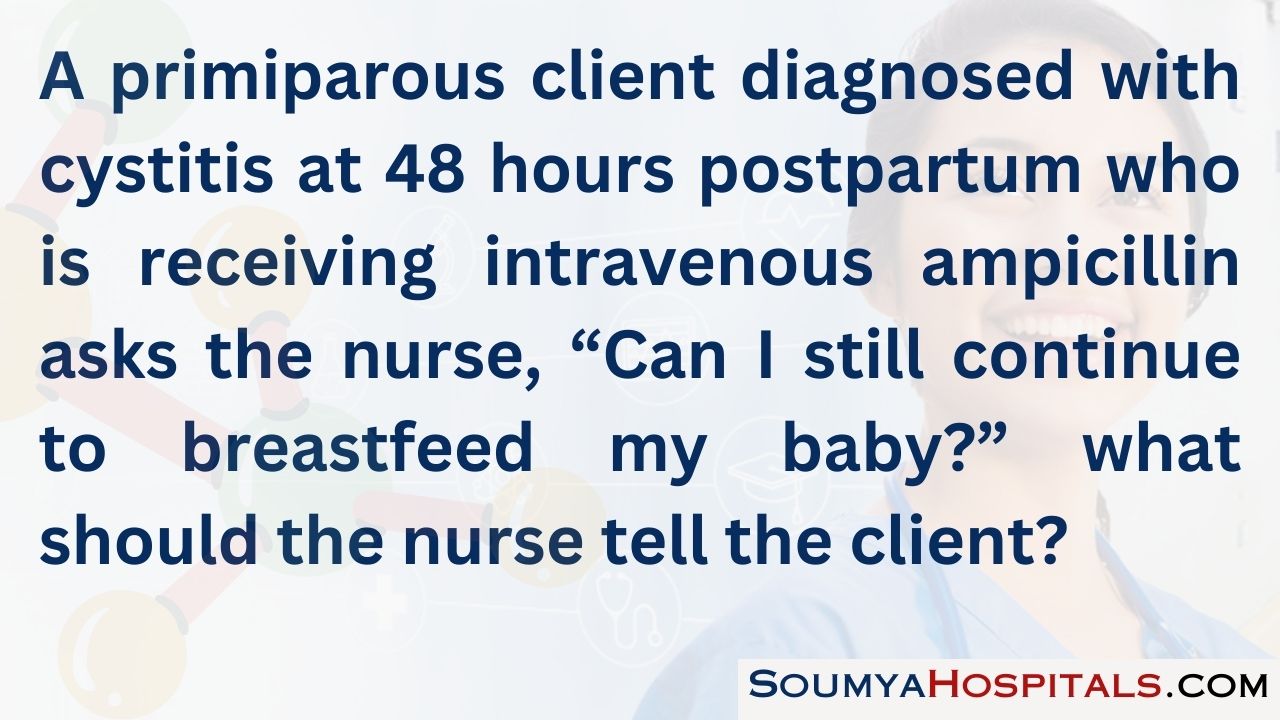
Explanation:
The client can continue to breastfeed as often as she desires. Continuation of breastfeeding is limited only by the client’s discomfort or malaise. Antibiotics for treatment are chosen carefully so that they avoid affecting the neonate through breast milk. Drugs such as sulfonamides, nitrofurantoin, and cephalosporins usually are not prescribed for breastfeeding mothers. Manual pumping of the breasts is not necessary.
Question 94.
Four days after vaginal birth, a client has excessive lochia rubra with clots. The health care provider (HCP) prescribes carboprost 0.25 mg intramuscularly. Which statement by the client reflects the need for more teaching about carboprost?
(a) “This medication may cause nausea and vomiting.”
(b) “This medication sometimes causes hypotension that leads to dizziness.”
(c) “I will also receive medication to help prevent severe diarrhea.”
(d) “I may run a fever after being treated with carboprost.”
Answer:
(b) “This medication sometimes causes hypotension that leads to dizziness.”

Explanation:
Carboprost tromethamine may cause hypertension, not hypotension. More commonly carboprost tromethamine, a synthetic prostaglandin, causes nausea, vomiting, diarrhea, and fever. Gastrointestinal symptoms are so common that antiemetic and antidiarrheal medications are often given as a pretreatment or immediately following carboprost.
Question 95.
During the first hour postpartum, an assessment of a multiparous client who gave cesarean birth to a neonate weighing 10lb, 2o (4,593 g) reveals a soft fundus with excessive lochia rubra. The nurse should include which interventions in the client’s plan of care?
(a) administration of intravenous oxytocin
(b) placement of the client in a side-lying position
(c) rigorous fundal massage every 5 minutes
(d) preparation for an emergency hysterectomy
Answer:
(a) administration of intravenous oxytocin
Explanation:
The client is exhibiting signs of early postpartal hemorrhage, defined as blood loss >500 mL in the first 24 hours postpartum. Rapid intravenous oxytocin infusion of 30 units in 500 mL of normal saline, oxygen therapy, and gentle fundal massage to contract the uterus are usually effective. If bleeding persists, the nurse should inspect the cervix and vagina for lacerations. Other pharmacologic interventions may be needed. Severe uncontrolled hemorrhage may require bimanual uterine compression, a dilation and curettage to remove any retained placental tissue, or a hysterectomy to prevent maternal death from hemorrhage.
The client should be placed in the supine position to allow evaluation of the fundus. The side-lying position is not helpful in controlling postpartum hemorrhage. Vigorous fundal massage every 5 minutes is unnecessary. In addition, it can be very painful for the mother. Rather, gentle massage along with oxytocin administration is used to stimulate the uterus to contract. A hysterectomy is used to remove fibroid tumors. With massive hemorrhage, a hysterectomy (removal of the uterus) may be necessary to control the bleeding.
Question 96.
A primiparous client who was diagnosed with hydramnios and breech presentation while in early labor is diagnosed with early postpartum hemorrhage at 1 hour after a cesarean birth. The client asks, “Why am I bleeding so much?” The nurse responds based on the understanding that the most likely cause of uterine atony in this client is which factor?
(a) trauma during labor and birth
(b) moderate fundal massage after birth
(c) lengthy and prolonged second stage of labor
(d) overdistention of the uterus from hydramnios
Answer:
(d) overdistention of the uterus from hydramnios
Explanation:
The most likely cause of this client’s uterine atony is overdistention of the uterus caused by the hydramnios. As a result, the stretched uterine musculature contracts less vigorously. Besides hydramnios, a large infant, bleeding from abruptio placentae or placenta previa, and rapid labor and birth can also contribute to uterine atony during the postpartum period. Trauma during labor and birth is not a likely cause.
In addition, no evidence of excessive trauma was described in the scenario. Moderate fundal massage helps to contract the uterus, not contribute to uterine atony. Although a lengthy or prolonged labor can contribute to uterine atony, this client had a cesarean birth for breech presentation. Therefore, it is unlikely that she had a long labor.
Question 97.
Thirty-six hours after a vaginal birth, a multiparous client is diagnosed with endometritis. When assessing the client, which symptom would the nurse expect to find?
(a) profuse amounts of lochia
(b) abdominal distention
(c) nausea and vomiting
(d) fever >100.4°F (38.0°C)
Answer:
(d) fever >100.4°F (38.0°C)
Explanation:
The classic symptoms of endometritis are fever and foul-smelling lochia. Odorless, heavy bleeding is associated with retained placental fragments. Abdominal distention is associated with parametritis as the pelvic cellulitis advances and spreads, causing severe pain and distention.
Nausea and vomiting are associated with parametritis, resulting from an abscess and advancing pelvic cellulitis. lacerations are commonly associated with early, not late, postpartum hemorrhage.
Question 98.
A multiparous client visits the urgent care center 5 days after a vaginal birth, experiencing per¬sistent lochia rubra in a moderate to heavy amount. The client asks the nurse, “Why am I continuing to bleed like this?” The nurse should instruct the client that this type of postpartum bleeding is most likely caused by which problem?
(a) uterine atony
(b) cervical lacerations
(c) vaginal lacerations
(d) retained placental fragments
Answer:
(d) retained placental fragments
Explanation:
The most likely cause of delayed postpartum hemorrhage is retained placental fragments. The client may be scheduled for a dilatation and curettage to remove remaining placental fragments. Uterine atony, cervical lacerations, and vaginal
Question 99.
A 26-year-old primiparous client is seen in the urgent care clinic 2 weeks after giving birth. The client, who is breastfeeding, is diagnosed with mastitis of the right breast. The client asks the nurse, “Can I continue breastfeeding?” What should the nurse should tell the client?
(a) “You can continue to breastfeed, feeding your baby more frequently. ”
(b) “You can continue once your symptoms begin to decrease.”
(c) “You must discontinue breastfeeding until antibiotic therapy is completed.”
(d) “You must stop breastfeeding because the breast is contaminated.”
Answer:
(a) “You can continue to breastfeed, feeding your baby more frequently. ”
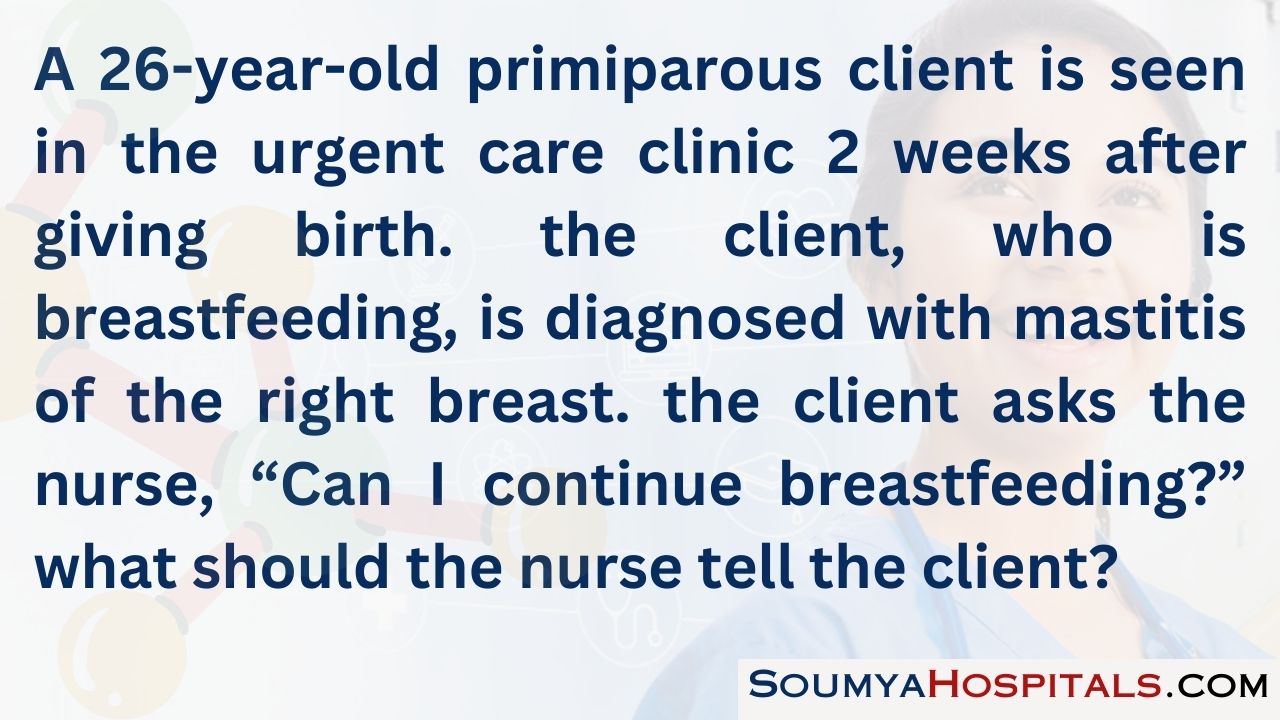
Explanation:
The client being treated for mastitis should continue to breastfeed often, or at least every 2 to 3 hours. Treatment also includes bed rest, increased fluid intake, local heat application, analgesics, and antibiotic therapy. Continually emptying the breasts decreases the risk of engorgement or breast abscess.
The client should not discontinue breastfeeding unless she chooses to do so. The client may continue breastfeeding while receiving antibiotic therapy. Generally, the breast milk is not contaminated by the offending organism and is safe for the neonate.
Question 100.
A primiparous client who had a vaginal birth 1 hour ago voices anxiety because she has a nephew with Down syndrome. After teaching the client about Down syndrome, which client statement indicates the need for additional teaching?
(a) “Down syndrome is an abnormality that can result from a missing chromosome.”
(b) “Down syndrome usually results in some degree of mental retardation.”
(c) “There are several methods available to determine whether my baby has Down syndrome.”
(d) “Older mothers are more likely to have a baby with chromosomal abnormalities.”
Answer:
(a) “Down syndrome is an abnormality that can result from a missing chromosome.”
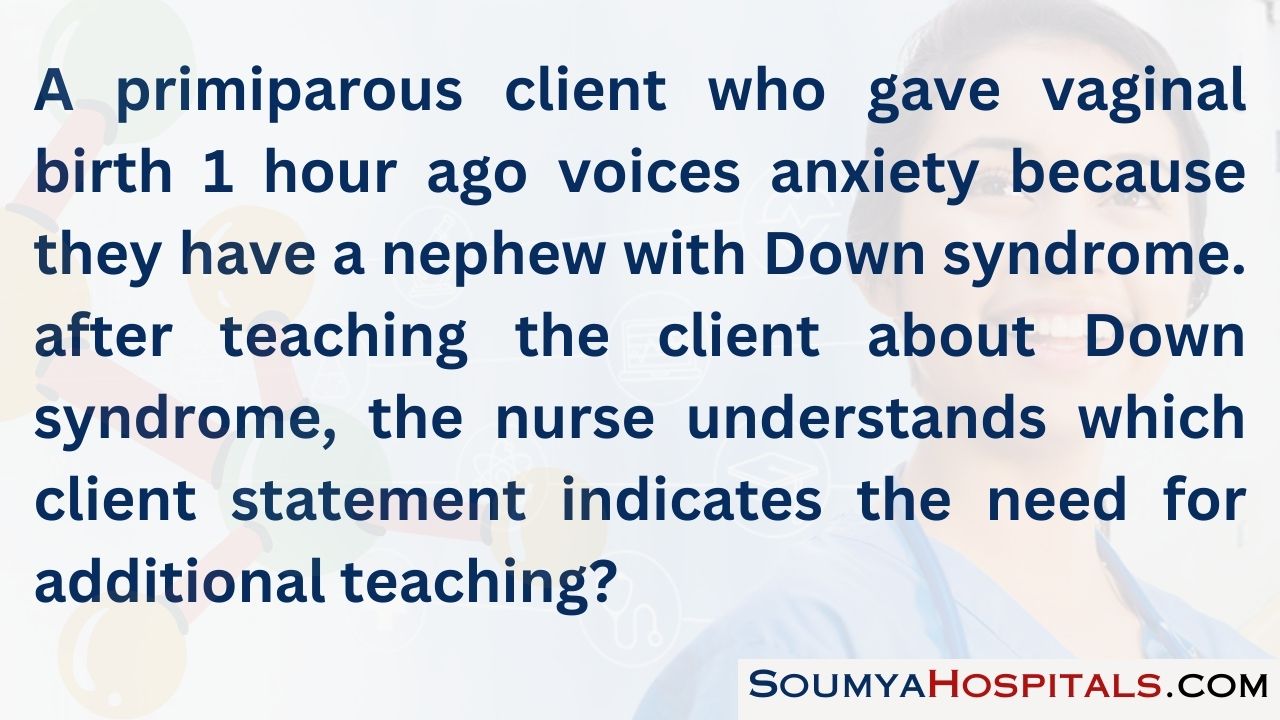
Explanation:
Down syndrome is a genetic abnormality that is caused by an extra chromosome that results in mental retardation. The degree of mental retardation is difficult to predict in a neonate, although most children born with Down syndrome have some degree of mental retardation.
Various methods can be used to determine whether a neonate has Down syndrome, which is commonly manifested by hypotonia, poor Moro reflex, flat facial profile, up-slanting palpebral fissures, epicanthal folds, and hyperflexible joints. Genetic studies can be indicative of this disorder. Mothers older than 35 years of age are at a higher risk of having a child with Down syndrome. However, chromosomal abnormalities can occur regardless of the mother’s age.
Question 101.
A 15-year-old primiparous client is being cared for in the hospital’s birthing center after the vaginal birth of a viable neonate. The neonate is being placed for adoption through a social service agency. Four hours postpartum, the client asks if she can feed her baby. Which response would be most appropriate?
(a) “I’ll bring the baby to you for feeding.”
(b) “I think we should ask your health care provider (HCP) if this is a good idea.”
(c) “It’s not a good idea for you to have any contact with the baby.”
(d) “I’ll check with the social worker to see if the adopting parents will permit this.”
Answer:
(a) “I’ll bring the baby to you for feeding.”
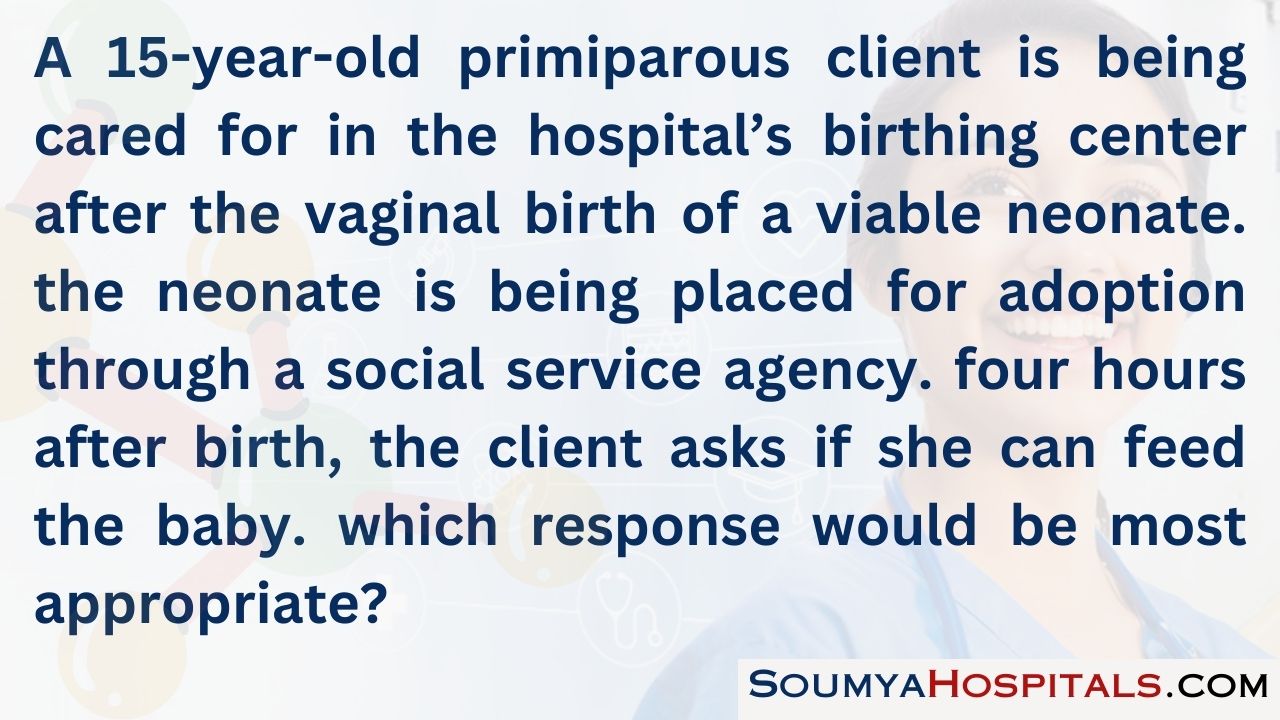
Explanation:
After birth, the client should make the decision about how much she would like to participate in the neonate’s care. Seeing and caring for the neonate commonly facilitates the grief process. The nurse should be nonjudgmental and should allow the client any opportunity to see, hold, and care for the neonate.
The health care provider (HCP) does not need to be contacted about the client’s desire to see the baby, which is a normal reaction. The social worker and the adoptive parents do not need to give the client permission to feed the baby.
Question 102.
After teaching a primiparous client about treatment and self-care for mastitis of the right breast, the nurse determines that the client needs further instruction when she makes which statement?
(a) “I can apply localized heat to the infected area.”
(b) “I should increase my fluid intake to 2,000 mL/day.”
(c) “I will need to take antibiotics for 7 to 10 days before I am cured.”
(d) “I should begin breastfeeding on the right side to decrease the pain.”
Answer:
(d) “I should begin breastfeeding on the right side to decrease the pain.”

Explanation:
The client needs further instruction when she says that she should begin feeding on the right (painful) breast to decrease the pain. Starting the feeding on the unaffected (left) breast can stimulate the milk ejection reflex in the right breast and thereby decrease the pain. Frequent nursing or pumping is recommended to empty the breast.
For some mothers, mastitis is so painful that they choose to discontinue breastfeeding, so these mothers need a great deal of support. Applying heat to the infected area before starting to feed is appropriate because heat stimulates circulation and promotes comfort. Increasing fluid intake is advised to ensure adequate hydration. Antibiotics need to be taken until all medication has been used, usually 7 to 10 days to ensure eradication of the infection.
Question 103.
A breastfeeding postpartum client experiencing breast engorgement tells the nurse that she has applied cabbage leaves to decrease her breast discomfort. What is the nurse’s best response?
(a) “Using cabbage leaves to relieve engorgement is considered a folk remedy.”
(b) “I’m concerned that the cabbage leaves may harm your nursing baby. ”
(c) “I need to notify your health care provider immediately that you’re using cabbage leaves.”
(d) “Let me know if you get relief using the cabbage leaves.”
Answer:
(d) “Let me know if you get relief using the cabbage leaves.”
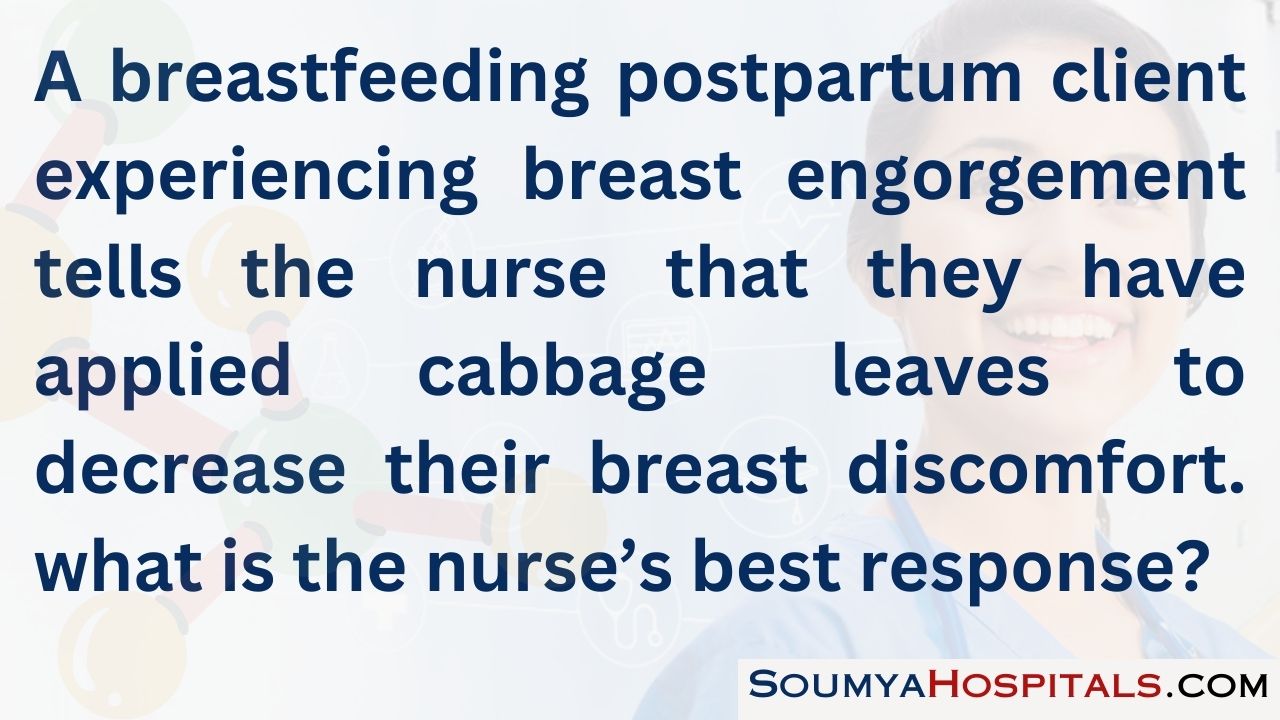
Explanation:
Holistic nursing honors the client’s preference for safe, alternative, and complementary practices. Cabbage leaves tucked into the bra is an alternative practice that may relieve pain and swelling from engorgement in some clients. Saying that using cabbage is a folk remedy does not address the safety or efficacy of the practice.
There are no known safety risks to using cabbage as a treatment for engorgement. The nurse should document the client’s use of cabbage leaves to treat the engorgement in the medical record, but there is no risk that warrants immediate notification of the health care provider.
Question 104.
During a home visit to a primiparous client who gave birth vaginally 14 days ago, the client says, “I have been crying a lot the last few days. I just feel so awful. I am a rotten mother. I just do not have any energy. Plus, my husband just got laid off from his job.” The nurse observes that the cli¬ent’s appearance is disheveled. What would be the nurse’s best response?
(a) “These feelings commonly indicate symptoms of postpartum blues and are normal. They will go away in a few days.”
(b) “I think you’re probably overreacting to the labor and birth process. You’re doing the best you can as a mother.”
(c) “It’s not unusual for some mothers to feel depressed after the birth of a baby. I’m going to contact your health care provider.”
(d) “This may be a symptom of a serious mental illness. I think you should probably go to the hospital.”
Answer:
(c) “It’s not unusual for some mothers to feel depressed after the birth of a baby. I’m going to contact your health care provider.”
Explanation:
The client is probably experiencing postpartum depression, and the health care provider (HCP) m should be contacted. Postpartum depression is usually treated with psychotherapy, social support groups, and antidepressant medications. Contributing factors include hormonal fluctuations, a history of depression, and environmental factors (e.g., job loss).
An estimated 50% to 70% of women experience some degree of postpartum “blues,” but these feelings of sadness disappear within 1 to 2 weeks after birth. However, the client is voicing more than just sadness. Telling her that she is over reacting is not helpful and may make her feel even less worthy. She is not exhibiting symptoms of a serious mental illness (loss of contact with reality) and does not need hospitalization.
Question 105.
A teen client, who is 1 week postpartum, is concerned about the possibility of postpartum depression because she has a history of depression. Which comment by the client would indicate that she understood the nurse’s teaching about the postpartum period and her risks for postpartum depression?
(a) “Sleep should not be too much of a problem because the baby will soon start to sleep through the night.”
(b) “Since I am breastfeeding, I can eat all the food I want and not feel fat. The baby will use all the calories.”
(c) “If I’m feeling guilty or not capable of caring for the baby and am not sleeping or eating well, I need to contact the office.”
(d) “I’m going to give the baby the best care possible without asking anyone for help to show all those people who think I can’t do it.”
Answer:
(c) “If I’m feeling guilty or not capable of caring for the baby and am not sleeping or eating well, I need to contact the office.”
Explanation:
Feelings of guilt combined with a lack of self-care (not eating or sleeping enough) can predispose a new mother to postpartum depression, especially one who has had previous episodes of depression. Sleep is essential to both the mother and baby, but sleeping through the night does not usually occur in the first few weeks after birth.
While breastfeeding mothers do need good nutrition, unlimited eating after birth may inhibit the return to a normal weight and could create depression in a new mother, especially a vulnerable one. Attempting to care for an infant with no help from others is likely to cause stress that could lead to depression, especially in an adolescent.
Question 106.
A multigravida prenatal client with a history of postpartum depression tells the nurse that she is taking measures to make sure that she does not suffer that complication, including taking St. John’s wort. What is the most important assessment for the nurse to make?
(a) current medications
(b) fetal growth
(c) liver functions
(d) mood status
Answer:
(a) current medications
Explanation:
St. John’s wort, an herbal supplement commonly used to treat mild depression, interacts with many medications, making them less effective. If the client is already taking a prescription antidepressant, she can be at risk for serotonin syndrome. St. John’s wort is not known to cause fetal growth or liver problems. It would be important to assess the client’s mood after determining if the client is at risk for medication interactions.
Question 107.
The nurse is catheterizing a client who cannot void after a normal birth 8 hours ago. The nurse begins the catheterization process, and the client states, “I forgot to tell (a) Document the incident.
(b) Clean povidone-iodine from the client’s vaginal area.
(c) Notify the health care provider (HCP) L prescribing catheterization.
(d) File an incident report.
Answer:
(b) Clean povidone-iodine from the client’s vaginal area.
(c) Notify the health care provider (HCP) L prescribing catheterization.
(a) Document the incident.
(d) File an incident report.
Explanation:
(b), (a), (c), (d) The nurse should then clean the solution from the client, notify the health care provider (HCP) of the incident, and ask for a prescription for medication if needed to counteract the povidone-iodine. The nurse will need to document the incident on the client’s medical record as soon as the client has physically been taken care of. The nurse also will need to file an incident report.
Question 108.
A nurse is walking down the hail in the main corridor of a hospital when the infant security alert system sounds and a code for an infant abduct ion is announced. The first responsibility of the nurse when this situation occurs is to take which action?
(a) Move to the entrance of the hospital and check each iwrson leaving.
(b) Go to the obstetrics unit to determine if they need help with the situation.
(c) Call the nursery to ask which baby is missing.
(d) Observe individuals in the area for large bags or oversized coats.
Answer:
(d) Observe individuals in the area for large bags or oversized coats.
Explanation:
The process for infant abduction in a hospital system focuses on utilizing all health care workers to observe for anyone who may possibly be concealing an infant in a large bag or under an oversized coat and is attempting to leave the building. Moving to the entrances and exits and checking each individual would be a responsibility of the doorman or security staff within the hospital system.
Going to the obstetrics unit to determine if they need help would not be advised as the doors to the unit will be locked and access will not be available. Calling the nursery to ask about a missing baby wastes time, and the nursery staff should not reveal such information.
Question 109.
The nurse on a mother-baby unit who is working on the night shift is revising the planning worksheet for the remaining 2 hours of the shift. The nurse has tasks and prescriptions to complete prior to the change of shift at 0700. Using the work plan below, how should the nurse organize the tasks from first to last so that everything is completed by 0700?
(a) Draw blood for the prescribed laboratory test1 (complete blood counts ICBCs]) on three post partum clients with report on medical records by shift change.
(b) Start IV of D5½ NS at keep vein open (KVO) rate on postpartum client just prior to change of shift.
(c) Complete admission assessment of newborn L turned over to nurse at 0500.
(d) Draw newborn hiliruhin level at 0600.
|
0500 |
|
|
0530 |
|
|
0600 |
|
|
0630 |
|
Answer:
|
0500 |
3 |
|
0530 |
1 |
|
0600 |
4 |
|
0630 |
2 |
Explanation:
Drawing the bilirubin levels at 0600 must occur at a specific time. The admission assessment should be completed as soon after admission as possible; 0500 is available to complete this task. The IV should be started at 0630 and completed as close to the change of shift as possible. The nurse should then draw the blood at 0530, right after the newborn asse.
Question 110.
A nurse is caring for a woman who gave birth to her baby boy 2 hours ago. The nurse notes that the woman's perineal pad contains some small clots and a moderate amount of lochia has accumulated tinder her buttocks. What is the first action the nurse should take at this time?
(a) Request a prescription to administer oxytocin.
(b) Perform an in-and-out catheter immediately.
(c) Measure blood loss by measuring the perineal pad.
(d) Check fundus for position and consistency.
Answer:
(a) Request a prescription to administer oxytocin.
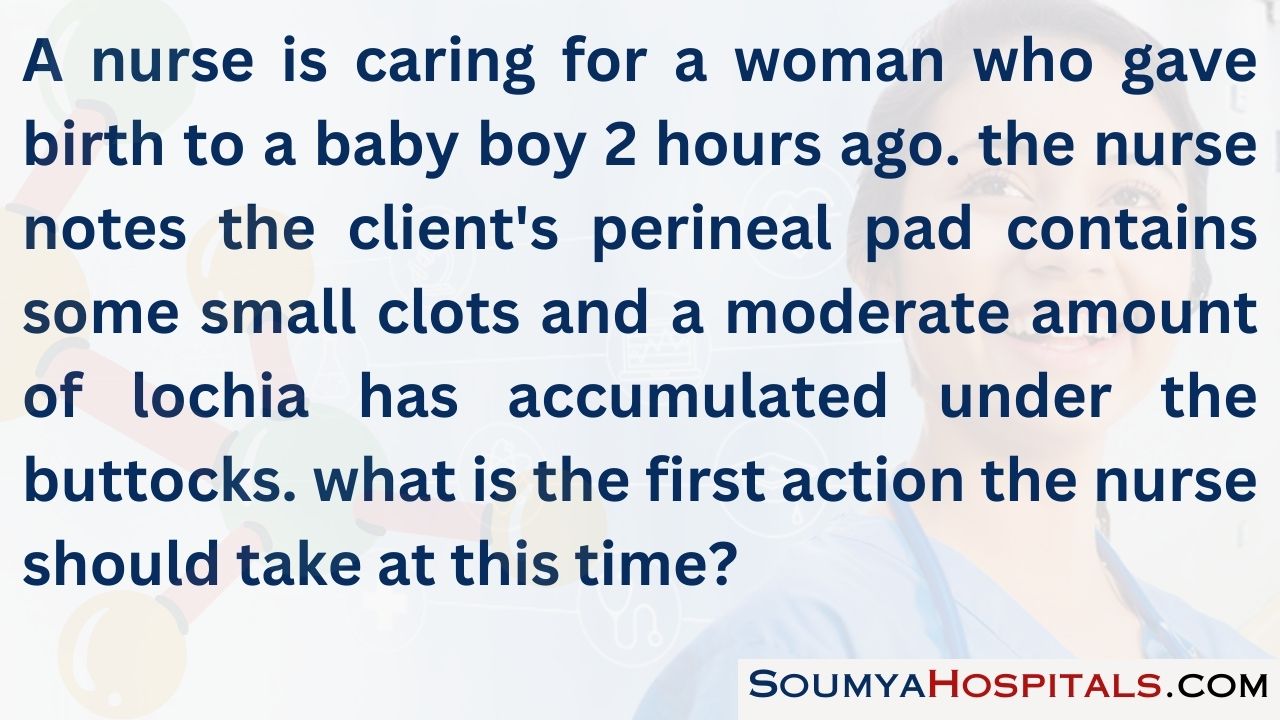
Explanation:
Hemoglobin (Hgb) values following birth remain close to that during pregnancy. This value would indicate a low Hgb value and requires further follow-up by notifying HCP and documentation. WBC of 18,000 x 109/L is considered normal during the postpartum period. This is the normal value for hematocrit.
A value of 9 mmol/L for serum iron is within the normal range. WBC is within the normal range for the postpartum period and will not require parenteral antibiotics. Vital signs can be assessed following contacting the HCP. Pain medication is not indicated at this time based on these lab values.
Question 111.
The nurse is reviewing the laboratory values on the medical record of a woman who is postpartum day 2. (Seo exhibit.)
|
History |
Labs |
Prescriptions |
|
1. Value |
Traditional Units |
SI Units |
|
2. WBC |
18,000 |
18 x L |
|
3. Hematocrit |
40% |
0.40% |
|
4. Hemoglobin |
9 g/dl |
90g/L |
|
5. Platelets |
400,000 |
40 x L |
Liased on this information, what should the nurse do?
(a) Contact 11w health care provider (HOE).
(b) Obtain a prescription for intravenous iìntibintica.
(c) Assess the woman’s vital signs.
(d) Prepare to administer pain medication.
Answer:
(a) Contact 11w health care provider (HOE).
Explanation:
(a), Foul-smelling lochia and an elevated temperature >100.8°F (38.2°C) are signs of a postpartum infection and should be reported to the HCP Q Bilateral engorgement is not an unusual finding and typically responds to nursing interventions such as use of ice packs. Postpartum blues can cause the client to cry easily for up to 2 weeks after birth. Soaking a peripad every 3 to 4 hours is a normal amount of lochia for a postpartum client within a week of birth.
Question 112.
The nurse a us,os a client, vlrn delivered vaginally 6 days ago. during a home visit. Which finding should the nurse report immediately to the health care provider (HCP)? Select all that apply.
(a) foul-smelling lochia
(b) engorged breasts bilaterally
(c) client who cries easily
(d) soaking I peripad every 3 to 4 hours
(e) temperature of 100,8F (38.2°C)
Answer:
(a) foul-smelling lochia
Explanation:
Safety is the highest priority, and a nursing error has occurred. If the day nurse decides to tell the night nurse, the timing of the notification will be up to the nurse initiating the incident report. The nurse should confer with the charge nurse concerning the incident, but completion of the report is required.
Waiting for several hours to initiate the report based on changes in client data and assessment is not an ethical or professional decision and should not be considered; again, safety is the highest priority.
Question 113.
The night nurse has completed the change of shift report. As the day nurse makes rounds on a post partuni client receiving magnesium sulfate, it is noted the client developed significantly elevated blood prus sure during the past shifi. Further assassinent reveals the magnesium sulfate rate is infusing well below the prescribed rate. In addition to adjusting the infusion rate and notifying the health care provider (HCP), what is the most important action by the nurse?
(a) Complete an incident repon.
(b) Discuss the matter with the nurse the next time she works.
(c) Ask the charge nurse if an incident report is necessary.
(d) Evaluate the clients BP or 4 hours before making a decision.
Answer:
(b) Discuss the matter with the nurse the next time she works.
(c) Ask the charge nurse if an incident report is necessary.
(d) Evaluate the clients BP or 4 hours before making a decision.
Explanation:
(b), (c), (d), The use of recycling bins on the unit does not impact safety or contribute to the quality of care. The infant identification system is a safety practice. Nursing influences the type of system used and how monitoring and identification occur, which improves the quality of care. The sibling and family visitation policy can be an excellent project. Sibling policies regarding visitation can influence safety (safety of mother and infant by keeping children with colds/flus, infections away from the obstetrics unit).
Nursing influences development of the policy utilized and implemented on a daily basis. Postpartum instructions represent an area where the skill level, quality, and quantity of instruction represent nursing contributions to care. The ability for a family to remain together during a hospital stay is important to families. The quality of the obstetrical experience can be enhanced or determined to be negative by this particular policy, one that is often looked at by these committees.
Question 114.
The nurse is serving on the Quality Improvement Committee for the maternity unit. Quality improvement projects for this unit impacting safet and quality of care include which projects? Select all that apply.
(a) use of recycling bins on the unit
(b) infant identification system
(c) sibling afl(I Family visitation policies
(d) postpartum discharge instructions
(e) rooming-in guidelines
Answer:
(a) use of recycling bins on the unit
(b) infant identification system
(d) postpartum discharge instructions
(e) rooming-in guidelines
Explanation:
(a), (b), (d), (e) The safety of clients on an obstetrical unit does include prevention of infant abduction. Safe medication administration guidelines apply in obstetrics as well as all units in the hospital system. Adequate nourishment on the unit is essential for promotion of breastfeeding and for those clients who want to eat shortly after birth, but it is not a safety concern.
Adequate restraints as used during procedures, such as circumcisions, are a safety concern. An infant always needs proper identification when admitted, discharged, and taken to or away from parents, and this is also a great safety issue.
Question 115.
A nurse working on the postpartum unit is asked to participate in the unit Client Safety Committee. What type of projects would the committee conduct for the unit? Select all that apply.
(a) prevention of infant abduction
(b) safe medication administration
(c) adequate nourishment on unit
(d) proper restraints during procedures
(e) maternal/infant identification system
Answer:
(a) prevention of infant abduction
(b) safe medication administration
(c) adequate nourishment on unit
(d) proper restraints during procedures
Explanation:
(a), (b) (c), (d) Specific safety concerns on an obstetrical unit include a very specific “hand-off report” [Q] after birth and recovery has been completed and the couplet is transitioned to mother- baby care. In any invasive procedure including tubal ligations and circumcisions, preprocedure verification is a standard procedure. Client education concerning the potential for infection in obstetrics is essential for any incision areas.
Infant abduction is an ever-present concern for those working in a mother-baby unit. Car seat instructions for new parents involve the infant being in the back seat of a car facing backward not in the front seat. Education for the family includes this important area.
Question 116.
A nurse who works on an obstetrical inpatient unit has been assigned to the client safety committee. What client safety goals are most applicable to this setting? Select all that apply.
(a)completing effective and timely “hand-off reports” between labor and birth staff and mother-baby staff
(b) ensuring that preprocedure verifications are completed by health care providers (HCPs) for any invasive procedure
(c) involving clients in education about cord infections
(d) identifying salety risks specific to the unit, such as infant abduction
(e) performing car seat instruct ion litai allows infants to ride facing backward in the front seat
Answer:
(a)completing effective and timely “hand-off reports” between labor and birth staff and mother-baby staff
(b) ensuring that preprocedure verifications are completed by health care providers (HCPs) for any invasive procedure
(c) involving clients in education about cord infections
(b) ensuring that preprocedure verifications are completed by health care providers (HCPs) for any invasive procedure
Explanation:
(a), (b), (c), (d) Specific safety concerns on an obstetrical unit include a very specific “hand-off report’ after birth and recovery has been completed and the couplet is transitinned to mother-baby care. In any invasive procedure including tubal ligations and circumcisions, preprocedure verification is a standard procedure.
Client education concerning the potential for infection in obstetrics is essential for any incision areas. Infant abduction is an ever-present concern for those working in a mother-baby unit. Car seat instructions for new parents involve the infant being in the back seat of a car facing backward not in the front seat. Education for the family includes this important area.
Question 117.
The nurse is making a postpartum visit at the home of a client who delivered 14 days earlier. After assessing the vital signs (temperature, 99°F [37.2°C]; pulse. 88 beats/mm; respiration rate, 20 breaths mm; and blood pressure. 112/60 mm Hg). the nurse records the other assessments. (See exhibit.)
table
Which finding indicates deLayed involution?
(a) vital signs
(b) fundus
(c) lochia
(d) edema of the ankles
Answer:
(b) fundus
Explanation:
The fundus descends at the rate of I to 2 cm/day and by 2 weeks is no longer a pelvic organ. The vital signs, breasts, heart, lungs, abdomen (with exception of fundus), lochia. perineum, and extremities are within normal limits.
Read More:
